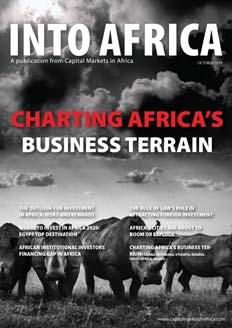











AFRICA EMERGING RISKS AND NEW OPPORTUNITIES IN 2020

ALGERIA AND ETHIOPIA: MACROECONOMIC OUTLOOK
ANGOLA, GHANA, KENYA: MACROECONOMICS IN 2020

SUBSAHARAN AFRICA: POLITICS, POLICY AND REGULATORY
POWER PROJECTS: RISK, BANKABIL ITY AND PROFIABILITY
PRESSURES REMAIN FOR SUBSAHARAN AFRICA SOVEREIGNS







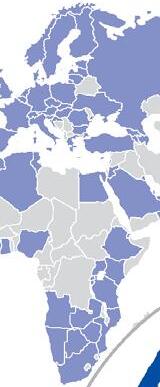
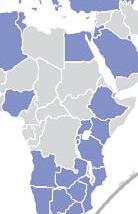








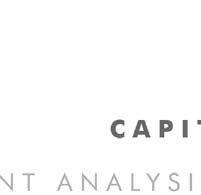
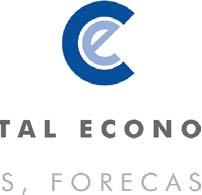
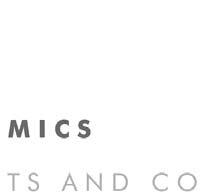

Editor Tunde Akodu
Associate Editor
Michael Osu
Feranmi Akodu
Advertising & Sales
Tola Ketiku
FEATURED ARTICLES
Africa: Emerging Risks and New Opportunities in 2020
Algeria and Ethiopia: Macroeconomic Outlook
Angola: Challenging Economic Environment Continues
Ghana: Macroeconomic Fundamentals and Prospects
Egypt: Post-Reform Focus is Key in 2020
Kenya: Macroeconomic Fundamentals and Risks
Morocco: A Timid Economic Recovery Expected in 2020
Nigeria FX Reserves: What Should We Expect in 2020?
South Africa: 2020 Macroeconomics and Risks
Zambia: Modest Rebound Growth Expected, Risks Remain High
Sub-Saharan Africa: Political and Policy Outlook
Declining Debt but Pressures Remain for Sub-Saharan Africa Sovereigns
SPECIAL FEATURE
Sustainable Power Projects: Risk, Bankability and Profitability
European Commission Set to Extend Investors Duties of Care to the Public and Benficisried in Addition to Shareholders
Mauritius: A Gateway for Investments into Africa
ECONOMIC WATCH
What analysts are saying about Africa’s economic outlook and financial stability.
Commodity prospects for 2020: Crude oil and base metals.

DISCLAIMER:
Wish you a prosperous year 2020 and welcome to the February 2020 edition of the INTO AFRICA, a publication written by the professionals, for professionals, investors, policymakers … Advancing and providing fresh insight into Africa’s emerging markets through renowned thought leadership and peer-to-peer knowledge-sharing. This edition provides insight and foresight into African economies from economists and analysts, hence the edition titled: Lens On Africa’s Economy in 2020.
Last year was a challenging one for the African continent. From an international perspective, geopolitical risks and a decrease in commodity prices weighed on African economic activity. On the domestic front, apart for country-specific dynamics hampering growth prospects, the biggest economies on the continent continued to struggle, weighing on neighbouring countries’ economic activity and subsequently overall African growth. Nonetheless, the outlook for the coming year is a bit more optimistic, largely driven by fading global uncertainties. The African Development Bank Group (AfDB) projected the real GDP growth of African economies to pick up from 3.4% in 2019 to 3.9% in 2020 and 4.1% in 2021, but to remain below the region's average growth rate of 5% in the past decade. Still, it noted that the region's outlook is subject to domestic and external downside risks, including extreme weather events, socio-political risks amid upcoming elections in several countries, and a slowdown in global economic activity. Besides, the recent coronavirus outbreak in China, which has also spread to different parts of the globe, will hurt the Chinese economy in the short term and this could subsequently affect resource rich African countries.
PIETER DU PREEZ (Senior Economist, NKC African Economics South Africa) opens the edition with a stimulating write-up titled “Africa: Emerging risks and new opportunities in 2019”, where he examines some of the risks and opportunities facing countries on the continent in the short to medium term. DANIEL RICHARDS (MENA Economist, Emirates NBD United Arab Emirates) and TIAGO DIONISIO (Chief Economist, Eaglestone Advisory) discuss in “Algeria and Ethiopia: Macroeconomic Outlook” and “Angola: Challenging Economic Environment Continues”, respectively. COURAGE KINGSLEY MARTEY (Senior Economic Analyst, Databank Group, Ghana) explores the Ghanaian economy in “Ghana: Macroeconomic fundamentals and Risk” and DAVID NGUGI GITAU (Investment Analyst, Cytonn Investments Kenya) reflects on Kenya in “Kenya: Macroeconomic fundamentals and Risks”
In the same spirit, RADWA EL SWAIFY (Head of Research, Pharos Securities Brokerage Egypt) and BMCE Capital Research Morocco provide their views in: “Egypt: Post-Reform Focus is Key for 2020” and “Morocco: A Timid Economic Recovery Expected in 2020”, respectively. Likewise, LYDIA RANGAPANAIKEN (Sub-Saharan Economist, FCMB Bank (UK) Limited) offers her opinion in “Nigeria FX Reserves: What Should We Expect in 2020” and ANNABEL BISHOP (Chief Economist, Investec Bank Limited South Africa) diagnoses the South Africa’s macroeconomic considerations. In parallel, THEA FOURIE (Senior Economist, Sub-Saharan Africa, IHS Markit Economics) distils Zambia economic prospects for 2020 and RODDY BARCLAY (Head of Intelligence and Analysis, Africa Practice) investigates Sub-Saharan Africa pollical and policy outlook for the year 2020. And, JAN FRIEDERICH (Head of Middle East and Africa Sovereigns, Fitch Ratings) opines that sovereigns in Sub-Saharan Africa largely absorbed the earlier commodity price shock, and median government debt will decline in 2020 after a marginal reduction in 2019.
Still more, we bring you special features, where HARU MUMBENGEGWI (Legal Counsel, African Legal Support Facility) and RON CHARI (Counsel, World Bank Group, Washington) examine risks, bankability and profitability of sustainable power projects in Africa. EDLINE EVA MURUNGI (Associate, Bowmans Uganda) looks at the new European Commission (EC) regulation framework which set to extend investor’s duties of care to the public and beneficiaries in addition to the shareholders. SHAILEN SREEKEESSOON (Deputy CEO, SBM NBFC Holdings Lt) showcases Mauritius as a gateway for investors wishing to finance projects and explore business opportunities in Africa.
On a final note, we provide you with a summary of what analysts are saying about Africa’s economic outlook and credit quality as well as the prospects of the commodity markets in 2020.
Cover Image: From pixabay.com
Modified image (merged several images) african-map-4794457 boy-509488 rand-currency-forecast-2
IN AFRICA or the authors or authors’ organisations as to the accuracy of the information contained and opinions expressed therein.
Editor
Connect with The Editor on Linkedin. Follow us on twitter @capitaMKTafrica. Subscribe to INTO AFRICA at http://eepurl.com/buHhNv or please send an email to intoafrica@capitalmarketsinafrica.com.
Please visit our website at www.capitalmarketsinafrica.com for the latest news, bespoke analysis, investment events and outlooks.
ENJOY!
By Pieter du Preez, Senior Economist, NKC African Economics South Africa

ast year was a challenging one for the African continent. From an international perspective, geopolitical risks and a decrease in commodity prices weighed on African economic activity. On the domestic front, apart for country-specific dynamics hampering growth prospects, the biggest economies on the continent continued to struggle, weighing on neighbouring countries’ economic activity and subsequently overall African growth. Nonetheless, the outlook for the coming year is a bit more optimistic, largely driven by fading global uncertainties.
Despite a bit more optimistic outlook, risks remain tilted towards the downside and the following are more specific risks that came to light recently or has built up over time and continue to weaken local economies.
Countries have been accumulating public debt at a rapid pace and this has the possibility to derail economic development. According to our data, the number of countries on the continent in which public debt as percentage of GDP exceeded the 60% threshold, rose from six in 2010 to a forecast of 18 end-2019. It is worrisome that a third of countries on the continent have moved over the prudent threshold. What exacerbates the issue is that six of the top 10 biggest economies are among those who have exceeded the threshold and two others are on the verge of doing so. Exceedingly high debt levels have raised debt servicing costs substantially and therefore crowds out the necessary capital spending needed to develop local economies. The inability of most African governments to curb recurrent spending could lead to the consumer ultimately bearing the brunt of authorities’ fiscal mismanagement. Raising taxes to soften the blow on the fiscal shortfall will only depress consumer spending and subsequently economic growth.
The recent coronavirus outbreak in China, which has also spread to different parts of the globe, will hurt the Chinese economy in the short term. The lockdown of certain cities, travel restrictions, shutdown in production and an overall decline in consumer spending will in all likelihood lead to
lower economic activity. We adjusted China’s growth forecast downwards by 0.6ppts to 5.4% for 2020. This could manifest in lower demand for commodities, which in turn would push commodity prices downward and subsequently affect resource rich African countries.
Some of the biggest economies continue to struggle. Nigeria’s economic activity has started to pick up but is still well below potential. South Africa’s economy is still battling to gain any traction and although growth seems to have bottomed out, the country’s problems continue to deepen and are expected to result in the country remaining in a low-growth trap. Angola – the second biggest economy in Southern Africa – is estimated to have contracted for a fourth straight year last year and is expected to extend that to a fifth in 2020. South Africa and Angola’s struggles have affected other countries in the region as numerous countries have started to feel the pinch.
The recent locust infestation in East Africa has the potential to create serious damage. At endJanuary the locusts already affected large parts of Ethiopia, Kenya, and started creating havoc in Uganda. Ethiopia was hardest hit and exposes the agricultural sector to further downside pressure considering the fact that the country is still recovering from droughts and floods. The infestations threaten food security in one of the continent’s most populous countries, which already faces significant food price inflation. Although the magnitude of the impact still needs to be assessed it will in all probability lead to a loss of agricultural output and drive food prices higher in the short term.
“Raising taxes to soften the blow on the fiscal shortfall will only depress consumer spending and subsequently economic growth.”
Voters in four of the fastest growing African countries go to the polls in 2020. In Ethiopia Prime Minister Abiy Ahmed looks assured of a victory if the August elections go ahead. In Côte
d’Ivoire the candidates for October’s presidential election are not yet known; we see a chance that President Alassane Ouattara will run for re-election, sparking widespread protests and possibly some paramilitary activity. In Tanzania we are confident that President John Magufuli will win a second term thanks largely to closing of the political space. In Ghana, President Nana Akufo-Addo should easily see off the challenge of former President John Mahama to secure a second term.
We see conflict in Africa’s Sahel countries intensifying, primarily due to soaring population growth with the added negative effects of climate change. Fatalities will keep climbing in remote areas, displacing larger numbers of people and increasing political risk in the affected countries as voters (and sometimes soldiers) throw out governments that can’t win the “war on terror.”
Despite risks tilted towards the downside, there were a couple of developments in recent months that provide opportunities for countries in the short to long term.
Diminishing geopolitical risk led by the US and China reaching a trade truce in January was a major positive development. The phase one trade deal has prompted an upward revision of China’s GDP growth forecast, however, the outbreak of the coronavirus mentioned earlier could erode this positive sentiment somewhat. Although the coronavirus will affect growth in the short term, the trade truce could have a longer lasting positive effect. Despite the onerous task of having to ratify a trade deal with the EU, the uncertainty surrounding Brexit also came to an end at end-January. Therefore, taking into consideration that China, the US and UK are some of African countries’ biggest trading partners, the latest positive developments bode well for the continent. Increased economic activity in these countries could lead to higher demand and boost Africa’s trade and raise African growth prospects.
The African Continental Free Trade Area (AfCFTA) agreement was signed into operational phase last year. The agreement has enormous potential and the ability to transform the African economic landscape in the future. However, we feel that the current targets for implementation are too optimistic. Nonetheless, countries with the most to-do with regards to aligning current tariffs and non-tariff barriers with AfCFTA requirements are afforded sufficient time to gradually align these policies, which will mitigate the shock when the agreement commences. Seeing that the manufac-
turing sector is set to gain the most under the AfCFTA agreement, the countries with larger manufacturing bases stand to benefit the most from the onset. However, it also offers countries with smaller manufacturing bases the time to implement policies, build relationships and most importantly improve infrastructure to form part of regional value-chains.
Some countries are becoming more business friendly, thus opening the economy for foreign investment and new opportunities. Ethiopia and Angola are two specific countries that have announced radical transformation plans, which include privatisation of a large number of stateowned enterprises (SOEs). The Angolan government announced in August that it will sell stakes in 195 different companies between 2019 and 2022, under the Angola Privatisation Programme (ProPriv). Ethiopia communicated its privatisation drive over the last 18 months. The government would retain majority holdings in the State-run airline, logistics, telecoms and energy companies, but SOEs in all other sectors, with the exception of financial services, could be up for sale.
Despite risks tilted towards the downside the continent still has enormous potential and investment opportunities. Countries need to realise this potential and transform policies to open up their respective economies for investors in order to achieve macroeconomic and fiscal stability, while improving socio-economic conditions.
“On the domestic front, apart for country-specific dynamics hampering growth prospects, the biggest economies on the continent continued to struggle, weighing on neighbouring countries’ economic activity and subsequently overall African growth.”
Contributor’s Profile
Pieter du Preez, Senior Economist for Ghana and Senegal. Pieter joined NKC African Economics in February 2016 as economist/econometrician, focussing on numerous African countries. Pieter has a BCom (Hons) degree in Econometrics from the University of the Free State. Pieter started his career through the cadet graduate programme at the South African Reserve Bank where he also worked in the Macro Models unit in the Research department.
By Daniel Richards, MENA Economist, Emirates NBD
In Algeria, a move away from the economic nationalism which was the cornerstone of the Bouteflika administration opens the door for greater foreign participation in the North African economy, with FDI and debt both likely to benefit. In the meantime, the new administration will endeavour to placate any remaining protesters while simultaneously seeking to boost growth above the lacklustre average of 2.0% averaged over the past five years.
Political risk has subsided
The political unrest which characterised Algeria in 2019 has subsided – though it has by no means abated completely. Presidential elections were held in December, returning Abdelmadjid Tebboune as the country’s new leader. Tebboune succeeds longserving president, Abdelaziz Bouteflika, who was effectively ousted by demonstrators earlier last year after his announcement to stand for another term was met with significant opposition.
Although the election was seen by some as a fig leaf, with many of the key opposition figures unwilling to engage, protests have decreased in recent weeks. However, the likelihood is that a marked failure to address some of the protesters’ key concerns will see a resumption of unrest. Not least amongst these concerns, the new government will be under pressure to demonstrate a commitment to generating jobs and opportunities for the legions of young Algerians looking for work – youth unemployment sits somewhere around 25%-30%. It remains to be seen just how drastic a change in economic direction the

government might make in order to achieve this, following the decades of insular policies adopted by the previous regime. In the meantime, the 2020 budget took care to maintain the politically sensitive subsidies which were provisioned for at the same 8.4% of GDP.
One of the key areas in which we expect to see a change in policy direction is in the debt space, and particularly Algeria’s historic aversion to issuing external debt, which has been equivalent to only around 2% of GDP in recent years; the only foreign debt issued since the turn of the millennium has been to the African Development Bank, and a 2005 law had even outlawed its issuance. Public debt generally is comparatively low, at around 40%, although this has risen markedly over the past several years of lower oil prices, from just 8% in 2014-2015. The previous government adopted the unorthodox policy of borrowing from the central bank, and while this did not ultimately prompt a spike in inflation, as had been a concern, central bank reserves built up during the period of high oil prices have continued to decline at a rapid clip.
As such, with the monetary financing model seemingly reaching its limit and as yet unable to produce any noticeable growth boost, we anticipate a more orthodox approach from the new administration. While this may ultimately lead to a greater outlay on debt servicing costs, these have been negligible to date at only around 1% of total spending. There is also a chance that the authorities might heed the IMF’s calls for a weaker currency as the ongoing decline in reserves makes it harder to sustain the dinar at its current levels, although for the time being the government’s eye on social stability will render this unlikely if it can be avoided.
The move towards a more open approach to borrowing was outlined in the 2020 budget, and confirmed by finance minister Mohamed Loukal who said that the government would seek ‘long - term loans that will be allocated only to strategic projects.’ Algeria was ranked 89th globally in the World Economic Forum’s Global Competitiveness Index 2019, with transport infrastructure for instance ranked 94th. As
such, the proposal to borrow in order to fund projects such as a transport network in Algiers or to go towards the 6.3mn TEU-capacity port being developed near Cherchell could see a boost to long-term growth.
Diversification key to long-term success
In the near term, we forecast real GDP growth of 2.0% this year, following an estimated 1.0% last year, which was weighed down by protests and uncertainty and a drop in oil production; output averaged 1.0mn b/d in 2019, down 2.0% on the previous year. While we do not expect any rebound in the oil industry in 2020, there is a greater chance for foreign investment into the sector under the new government, a necessity which was reportedly underlined in a leaked letter from state oil firm Sonatrach. In the note, it said ‘It is more than ever necessary and urgent to enact a new hydrocarbons law adapted to international context, while enhancing Algeria's competitiveness advantage.’ To this end, a new hydrocarbon law was introduced in January which aims to restore the sector’s attractiveness for investment through a more favourable tax burden and contract terms. Taxes on Sonatrach and its foreign partners were reduced from 85% to 60-65%
Nevertheless, the prospects of a renewed expansion in oil production to the magnitude needed to solve the country’s economic ills remains unlikely, even in the long term, and so it makes sense that President Tebboune has been talking up the necessity of diversification, saying that his growth model ‘must allow the national economy to free itself from dependence on hydrocarbons, essentially through the encouragement of alternative and renewable energies.’ With regards to this, the relatively strong growth of industrial production ex-hydrocarbons last year (an average of 6.5% y/y over Q1-Q3) is a posi-
tive development, especially as compared to the average 1.1% y/y over the same period in 2018. Energy and iron & steel production were the outperformers.
A new deal struck between Ethiopia and the IMF in December could pave the way for greater opening up of the African economy, providing scope for increased cooperation between it and the UAE. Relations between the two countries have been strengthening in recent years, and the Ethiopian market of 105mn people – the fastest-growing economy in the world over the past decade, and tipped to become the manufacturing hub of SubSaharan Africa – could provide significant opportuniities to GCC firms
Economic and political liberalisation continues apace We have written previously how the accession of Abiy Ahmed as Ethiopian prime minister in 2018 heralded an economic and political sea change in the landlocked East African economy. The new leader rapidly pursued political détente at home and achieved a peace deal with neighbouring Eritrea after some 20 years of largely frozen conflict – an achievement which won him the Nobel Peace Prize in October last year. Equally significant, he has also overseen a renewed push towards economic liberalisation, moving away from the state-driven development model which had to now been the modus operandi of the formerly socialist country.
While progress on some of the government’s economic aims has arguably been slow – the part privatisation of Ethio Telecom being a case in point –the government remains committed to its ‘Homegrown Economic Reform Plan’, and the new deal with
the IMF underscores this. Under the agreement, Ethiopia will receive USD 2.9bn over three years to support the programme, which ‘aims to address foreign exchange shortages and external imbalances; reform state-owned enterprises (SOEs); safeguard financial stability; and strengthen domestic revenue mobilisation’ according to the IMF statement.
Further birr devaluation likely
What the IMF’s support will likely entail is a managed devaluation of the birr, widely held to be significantly overvalued at its current ETB 32.18/USD, even following a sizeable 15% devaluation in October 2017. Indeed, there has already been a move lower since December as the currency fell from ETB 30.59/USD at the start of last month to its present level, moving it gradually closer to its more realistic black market rate of around ETB 40/USD.
While Ethiopia has achieved spectacular growth of late, averaging 9.5% over the past 10 years, this has not come without a cost to its macroeconomic stability. The current account deficit has been persistently wide (6.4% of GDP last year), government debt has risen to 62% of GDP, and FX reserves have been perilously low at times. These imbalances were brought to the fore as domestic political risk rose in 2018, slowing remittances and other FX inflows, and prompting the UAE to deposit USD 1bn at the central bank in June in order to support the economy. The UAE also pledged USD 3bn in aid and investments to the country.
A more competitive currency, combined with easier access to foreign firms, the partial privatisation of key state assets, and the policy anchor and financial support provided by the IMF, should help entice greater inflows of foreign capital into Ethiopia, and the UAE and other GCC economies are likely to be
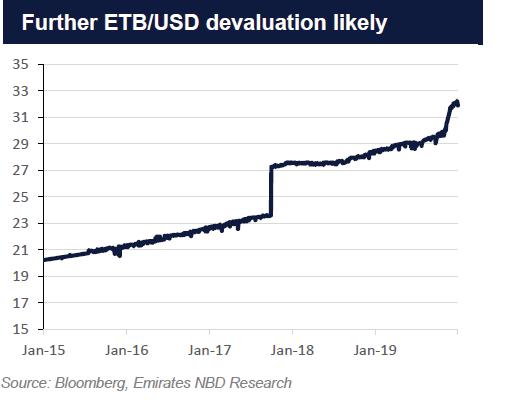
watching these developments with interest. The IMF support has been described as a Western great power counter play to the massive Chinese investment into the country, with Chinese entities having loaned over USD 13bn over 2006 to 2015 according to the Financial Times.
However, we believe that the Gulf states are perhaps the best placed to capitalise on any further liberalisation, especially given the support given by the UAE to Ethiopia over the past few years for instance. This has not only been financial, but the Gulf was also instrumental in brokering the rapprochement between Ethiopia and Eritrea.
This engagement has continued apace in recent months, and in November, the UAE’s minister of economy, Sultan bin Saeed Al Mansouri, received the Ethiopian trade and industry minister, Fetlework Gebre-Egziabher, with the two emphasising their cooperation in a number of fields. Al-Mansouri described Ethiopia as ‘an essential gate for the UAE’s investments in East African markets.’ From a logistical standpoint, this is supported by the growing presence of DP World in the region, which through its concession at the Somaliland port of Berbera, and logistics centres in landlocked Ethiopia itself, stands in a good position to facilitate greater trade flows between the two countries.
Contributor’s Profile
Daniel Richards is Emirates NBD’s MENA economist, covering markets in North Africa and the Levant. Prior to joining Emirates NBD, Daniel served as Head of MENA Country Risk and as a senior Sub-Saharan Africa analyst for BMI Research, in London. He holds an MA in International Relations of the Middle East and a BA in Arabic, both from the University of Exeter, UK.
By Tiago Dionisio, Chief Economist, Eaglestone Advisory
Economic activity in Angola contracted for a fourth straight year in 2019 mainly due to a strong decline in oil and gas production that reflects recent underinvestment in the sector following the sharp fall in oil prices at the end of 2014. The lower oil proceeds and the need to secure some fiscal deficit adjustment led to a marked decline in capex levels in recent years. This strategy only exacerbated the downturn in economic activity, as public investment remains a key source of growth of the non-oil sector, which now represents more than 65% of the country’s GDP (vs. less than 45% a decade ago).
Current forecasts suggest that real GDP declined 1.1% in 2019 after falling 1.2% in the previous year. In particular, activity in the oil and gas sector continued to see a material decline (estimated at 5% YoY after already tumbling 9.5% in 2018) while growth in the non-oil sector remained quite modest (forecast of 0.6% vs. 1% in the previous year).

kwanza (36% in 2019 vs. 46% in the previous year).
Moreover, the measures introduced by the BNA in the foreign exchange market led to a significant improvement in the access to foreign currency by local market participants as well as a reduction in the differential between the kwanza exchange rate in the official and parallel markets. Specifically, this differential narrowed from a peak of 150% before the introduction of a new foreign exchange regime in January 2018 to around 23% in December 2019.
On the fiscal front, the years 2018 and 2019 marked an inflection point in terms of the budget deficit trajectory of the recent past as both the primary and total fiscal balances stood in positive territory. This notwithstanding, public debt levels continued to climb to nearly 90% of GDP (from below 40% in 2014 before the oil crisis commenced), standing well above the 60% level considered a reasonable threshold.
Angola’s external position weakened relatively to 2018 on the back of lower oil prices and production, but remained in surplus, while international reserves saw a sharp increase towards the end of the year. This was due to the Eurobond issue of US$ 3 billion in November, which lifted net reserves to close the year at US$ 11.84 billion (+11.2% YoY), equivalent to about seven months of imports.
Meanwhile, inflation kept a downward trajectory thanks to a persistently tight monetary policy adopted by the BNA (the central bank) and the implementation of price control measures for some goods. Recall that inflation peaked above the 40% level at end-2016 due to the gradual elimination of fuel subsidies and some depreciation of the local currency (18%).
In 2019, yearly inflation reached 16.9% (below the government’s forecast of 17.5% and the lowest level since 2015) and average inflation stood at 17.08%. This despite consumer prices being affected by (1) adjustments in some administered prices, including electricity tariffs, (2) the introduction of the VAT and (3) the sharp depreciation of the
Angola continues to face a challenging economic environment, as persistent oil price volatility coupled with the need to continue to adopt tight fiscal and monetary policies likely impact the country’s growth trajectory in the foreseeable future. Economic
less, albeit very modestly.
Real GDP growth is projected to stand at close to 1% this year and increase to 2.5%-3% in 2021-22. Activity in the oil and gas sector is expected to recoup from a very weak performance in the recent past while growth in the non-oil sector gradually advances at a faster pace. Higher growth in the non-oil sector is also likely to reflect the positive effects of greater exchange rate liberalization and, in part, the government’s structural reforms aimed at diversifying the local economy.
It is worth noting the new Private Investment Law introduced in June 2018 that establishes the guidelines for private investment. This law is applicable to all investments in the country and, contrary to the prior legislation, it does not include any minimum required amount or demand for a local partner. Incentives will be granted depending on the sectors that the investment is made (namely those activity sectors that contribute to import substitution, increase in exports and economic diversification) and its location.
The government also recently launched a Privatization Program (PROPRIV) that aims to restart activity in the private sector and reform public finances. In particular, the government plans to start the privatization of 195 entities/assets in the period 2019-22 through the stock market or a tender. The aims of the PROPRIV include (1) promoting macroeconomic stability, (2) improving the productivity of the local economy and (3) distributing in a more equitable manner the income of the country.
The government’s 2020 budget assumes that oil production will recover from the levels recorded in recent years based on the stabilization in the output from France’s Total oil project at the Kaombo Sul area, which is currently Angola’s biggest deepwater offshore development, and the start of production in other oil fields. Oil prices are also expected to average US$ 55 (the same assumption as in the 2019 budget). This may prove to be on the conservative side bearing in mind current consensus forecasts for oil prices. The 2020 budget assumes a fiscal surplus of 1.2% and primary surplus of 7.1% of GDP, meaning that public accounts could be in positive territory for a third consecutive year.
Inflation is expected to increase to about 25% largely as a result of the gradual adjustment in fuel prices and the rapid depreciation of the kwanza. This goes against the government’s goal for inflation not to increase after 2018 and for consumer prices to gradually decline toward single-digits by end2022.
Angola’s long-term growth outlook will depend on the implementation of structural reforms. These reforms will be very relevant in order to correct the imbalances that persist and also improve the business environment to attract more foreign direct investment to the country.
Moreover, the BNA introduced some key legislation aimed at increasing the amount of credit granted to investment projects that contribute directly and indirectly to the national production and, as a result, reduce the large import dependency. First, the central bank announced that the banks operating in Angola will have to grant credit specifically for these types of projects in an amount equivalent to 2% of their total assets (at the end of the previous year) at a total cost (interest plus commissions) no greater than 7.5%. And, second, the Credit Support Programme (PAC) for the period 2019-22 aims to make it easier to grant credit to the companies operating in the production and commercialization of 54 essential goods for the local population.
In sum, the Angolan authorities are expected to remain strongly committed to addressing existing imbalances, together with the assistance of the current IMF program. Economic diversification remains a key priority for the government in its strategic objective to gradually replace imports with local production. The evolution of economic activity will depend on the improvement in crude production and a faster expansion in the non-oil sector. The continued implementation of reforms to bolster business environment should help to improve activity in the non-oil sector, lowering Angola’s persistently high dependence on oil and reducing the risks to its economic outlook.
FUNDAMENTALS AND PROSPECTS
By Courage Kingsley Martey, Senior Economic Analyst, Databank Group Ghana

iscal performance in 2019: Aggressive revenue collections in Q4-2019 partly offset shortfalls in previous quarters but non-tax revenue exerted a drag on total revenue.
Ghana endured elevated fiscal risks in 2019 as sharp deviations between revenue targets and outturn prompted a 50bps increase in the FY-2019 deficit target to 4.7% of GDP.
Our analysis of historical revenue performance from Q1-2016 to Q3-2019 revealed heightened uncertainty in revenue outturn (compared to targets) since 2018. Notably, revenue performance in 2019 indicated widened quarterly shortfalls compared to the outturn for the first three quarters of the year. Based on the 9-months provisional fiscal data, we estimate the cumulative revenue shortfall at GH¢5.71 billion (1.65% of GDP) compared to GH¢2.40 billion (0.8% of GDP) in the same period 2018.
The FY-2019 outturn for Total Revenue & Grants however, showed a shortfall of GH¢1.59 billion (0.5% of GDP), representing a lower shortfall than suggested by the 9-months trend. We believe the new tax handles introduced in the 2019 mid-year review and implemented in Q4-2019 were crucial in reducing the overall revenue gap in 2019. We also view the aggressive enforcement of tax compliance, ostensibly induced by management changes at the Ghana Revenue Authority, as an additional force behind the improved tax revenue collection in Q4-2019.
We however note the continued shortfall in non-tax revenue in 2019, equivalent to 0.4% of GDP. This resulted in a 4.8% overall budget deficit for FY-2019, overshooting the revised target by 0.1% of GDP.
The government’s resolve to contain the budget deficit within the 5% legislative cap was reflected in expenditure cuts in 2019, estimated at GH¢2.5 billion (0.7% of GDP). However, elevated spending pressure (particularly on interest payments, national security, energy sector obligations and social intervention programmes) prevented ample
cuts in expenditure to prevent the marginal fiscal overrun.
Source: Ministry of Finance, Databank Research
Fiscal outlook for 2020:
The ambitious revenue target for 2020 with a potentially higher borrowing requirement tapers our optimism .
Ghana’s 2020 budget projects a 26.7% year-onyear growth in Total Revenue & Grants to GH¢67.1 billion (FY-2019 outturn: GH¢52.97 billion). This revenue outlook is based on expected 12-month inflows from the tax measures implemented in late-2019 supported by ongoing reforms in tax administration and continued enforcement of tax compliance.
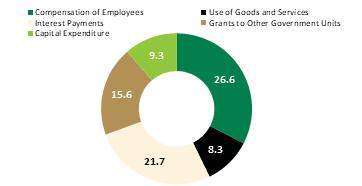
While we are optimistic about improved tax collections on the back of the new measures, our optimism is rather tapered by the inefficiency and technological constraints in domestic revenue mobilization. We also reckon that the political consequences of aggressive tax measures in an election year could soften the authorities’ stance, potentially restraining revenue growth.
We expect spending pressures to remain intense in 2020, largely driven by interest payments, infrastructure spending, social intervention policies and a one-off budget for the 2020 elections. This could pose an upside risk to the overall budget deficit in 2020, resulting in higher borrowing requirements for the year. We, however, expect the fiscal reforms (such as the Fiscal Responsibility Act and PFM Act) to provide crucial restraints. Against our expectations of public expenditure and revenue dynamics, we forecast the overall fiscal deficit at 4.9% ± 0.5% by end-2020 (Government Target: 4.7% of GDP).
Currency market review:
Heightened policy uncertainty weighed down on the Ghana Cedi in 2019.
The Ghana Cedi suffered significant losses in 2019 as investors priced-in the risk of a lax post-IMF policy environment following a raft of unexpected fiscal and monetary policy outcomes. Key among the unexpected policy developments in 2019 were: (1) The 100bps cut in the MPR to 16% in Jan-2019 (2) The Feb-2019 interbank forex market directive which increased the minimum tenor for FX swaps between non-resident and resident counterparties to 3-months.
The subsequent publications of weaker fiscal and public debt data further dented investor confidence in the policy outlook and intensified the outflow of foreign capital, weighing down the Cedi’s valua-
tion. Although a $3 billion Eurobond inflow lifted the Ghana Cedi in Mar-2019, fundamental fiscal concerns returned to the fore to deepen the Cedi’s FY-2019 loss to 12.90% on the interbank forex market.
Currency outlook for 2020:
We are optimistic on the monetary policy support for exchange rate but cautious on the fiscal side.
We feel assured by the posture of the monetary authorities in maintaining a broadly stable Ghana Cedi in 2020. Our optimism is grounded in the Bank of Ghana’s bi-weekly FX forward auctions which would deepen forward trading and limit spot market pressures.
The Bank of Ghana (BOG) published its FX forward auction calendar for 2020, signaling its plan to inject a cumulative size of US$715 million into the forex forward market in 2020. We note a relatively higher forward auction target of $40 million planned for Q1-2020 compared to $25 million per auction after Q1-2020. We view the higher-sized allotments for Q1-2020 as reflecting the Bank of Ghana’s commitment to increase forward activities in Q1-2020 when seasonal pressures tend to shock the spot market. We expect the government’s plan for early issuance of a $3 billion Eurobond to bolster the Bank of Ghana’s capacity to execute its FX forward auctions. Besides the forward market interventions, we also expect intermittent forex sales on the spot market to limit short-term volatility.
We further expect more cautious policy rate decisions in 2020 with a potential for a hold at the Jan-2020 MPC meeting as fiscal risks are expected to remain elevated in 2020.
On account of the anticipated BOG support, partly offset by fiscal risks to the outlook, we obtain our year-end 2020 forecast for USDGHS interbank rate at GH¢6.05 ± GH¢0.10 (FY-2020 Depreciation: 8.60% ± 1.50%).
We, however, note that stronger-than-expected negative shocks potentially from the electionsdriven uncertainty could cause the USDGHS to overshoot our forecast while a more credible fiscal evolution would cap the depreciation pressures.
By Radwa El Swaify, Head of Research, Pharos Securities Brokerage Egypt
hree years post its major macroeconomic transformation program, Egypt is going into 2020 at much stronger grounds than the last decade. We expect real GDP to pick up to 5.9% in FY19/20, up from 4.2% in FY16/17 and 2.2% in FY11/12. The growth will continue to be mostly driven by the transportation, communication, tourism, and manufacturing sectors. It is notable that we account for a gradually declining share of the construction sector this year, on the back of normalized business activity in that sector compared to the previous two years. Historically, around 80% of GDP has been derived from household (HH) consumption every year. HH consumption has been rising both on the back of a wider consumer base as well as the per capita spending value, in both real and nominal terms.
Inflation, which had been one of the most pressing items on the macro agenda, post local currency floatation in 2016, has been massively decelerating, helped by the recent strength in the Egyptian Pounds versus the US Dollar, lower commodity prices, and major focus by the government on regular supply of fruits and vegetables to avoid volatility in the CPI reading. We expect the inflation rate to decelerate to an average of 5.1% in FY19/20.
After bearing the brunt of raising rates between 2015 - 2018, by c.800 bps, mainly to control the spike in post-float inflation and avoid dollarization, the Central Bank of Egypt (CBE) has started a focused cycle of monetary easing in 2019, reducing rated by 450 bps. We expect the CBE to cut another 200-300 bps over the course of 2020, lowering overnight lending rate to 10.25%-11.25% by 2020 year end, from 13.25% end 2019.
We expect the Balance of Payments to record a surplus of USD0.5 billion in 2019/20 that steadily grows to USD2.0 billion by 2022/23. We project the current account deficit to decline to 1.7% of GDP in FY2019/20. Some of the key sources of foreign currency for Egypt will continue to be: 1) a growing petroleum trade surplus, after the recent domestic self-sufficiency in gas production and the expected

rise in gas exports by an average of USD500 million annually over the next three years as the government ramps up production; 2) healthy remittances at USD24 billion in FY19/20; 3) Tourism receipts of USD15.0 billion in FY19/20; 4) Foreign Portfolio Investments (FPI) are expected to normalize to USD4.5 billion in FY19/20 and USD3.5 billion in FY20/21 as the CBE reduces interest rates below peak levels of FY16/17. It is notable that Egypt’s treasury instruments remain very attractive relative to other EM countries and developed economies, offering the highest 2019 real yield of 5.3% on long tenor bonds in November 2019, while developed economies offer negative real yields.
Net International Reserves (NIR) should slowly build up from USD44.4 billion in FY18/19 to reach USD49.0 billion by FY22/23, on the back of tourism pick-up, remittances stability, and solid FDIs, at least in the oil and gas sector. These dynamics should allow NIR to cover 8-9 months of merchandise imports over the forecast horizon.
We believe that the nominal exchange rate will continue to gradually strehgthen over the course of 2020, to end the year at around EGP15.00/USD, tied to three key factors: 1) Favorable global monetary conditions. The current monetary policy in advanced economies, along with increasing reserves, stable interest rate gap, and lower inflation, would reduce pressures on the exchange rate in favor of its appreciation. 2) Foreign currency inflows reflected on the narrower current account deficit; 3) A favorable decline in inflation differential between Egypt and its trading partners.
Total Debt is projected to steadily decline to 110% of GDP in FY19/20 and hit EGP7.1 trillion (USD434 billion), from 115% in FY18/19 and EGP6.1 trillion. We expect debt accumulation to decelerate on three factors: 1) Continuing fiscal consolidation through reducing public expenditure and subsidies; 2) Shifting towards less costly sources of financing by gradually increasing the portion of external debt through Eurobond auctions and Euroclear certification. External debt’s share surged from an average
of 15% of total debt during FY14/15-16/17 to 30% in FY18/19; 3). The supportive macroeconomic environment over the next three years would help reduce the debt ratio and decelerate the debt accumulation speed.
Although we continue to be quite confident about the prospects of the economy in 2020, but any emerging market turmoil, global growth threats, or geopolitical risks, might affect the pace of reforms, local growth potential, and foreign currency inflows into Egypt.
We believe Egypt will continue to focus on higher share of the industrial sector in GDP growth, attracting higher foreign direct investments (FDI) in the industrial sector, to reduce reliance on oil & gas generated FDIs, slow the pace of debt accumulation through continuous fiscal consolidation, and increase the potential of the tourism sector as a





key source of foreign currency.
Contributor’s Profile
Radwa El Swaify brings with her 18 years of experience in investment advisory. El Swaify joined Pharos Holding as Head of Research in 2016, making the move from Beltone Financial, where she was the Head of Regional Equity Research. Prior to that, El Swaify served as Financial Sector Specialist with The World Bank Group in Washington D.C., and was the Sector Head for Financial Institutions Research at Beltone Financial. Her vast experience in the industry includes working closely on several countries in the MENA and Latin American regions, closing numerous corporate finance transactions in the MENA region during her time at HC Securities and Investment, where she began her career in Egypt. El Swaify holds an MBA and BA in Business Administration from The American University in Cairo (AUC).



















By David Ngugi Gitau, Investment Analyst, Cytonn Investments Kenya
enya’s economy recorded an average growth of 5.4% in the first three quarters of 2019, which was a decline from an average of 6.0% in a similar period of review in 2018. The subdued growth was mainly attributable to a slowdown in agricultural activities due to delayed onset of the long rains, which curtailed agricultural production. This saw the sector which has the highest contribution to GDP standing at 18.3% as at Q3’2019, record an average growth of 4.2% in the first three quarters of 2019, a decline from 7.0% in a similar period of review in 2018.
We project the country’s GDP growth in 2020 to range between 5.6% and 5.8%, supported by:
i. A pick up in private sector credit growth: The Finance Act 2019 repealed section 33b of the Banking Act that had capped lending rates at 4.0% above the Central Bank Rate (CBR), and deposit rates at 70.0% of the CBR. Following the amendment, there are expectations of improved market liquidity, coupled with improved access to credit by Micro, Small and Medium Enterprises (MSMEs) that will boost household consumption. This is because banks will now have sufficient margin to compensate for risks, as opposed to the interest rate cap era, where the focus was mainly in asset classes with higher returns on a risk-adjusted basis, such as government securities on account of the difficulty to price the SMEs within the set margins, as they were perceived “risky borrowers”.
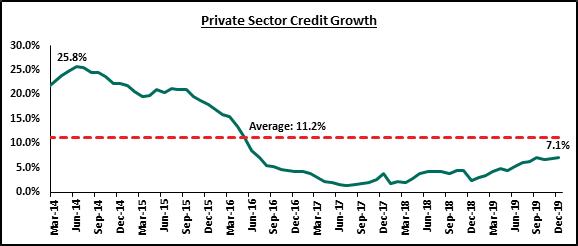
ii. Stable growth of the agricultural sector: This is mainly expected to be driven by improved weather conditions, coupled with the spill over effects from the heavy rains experienced in Q4’2019 as well as increased budgetary allocation to the sector for ongoing irrigation projects, strategic food reserves, cereal and crop enhancement and crop insurance schemes, in

order to enhance food security and nutrition, and,
iii.Public infrastructural investments: This is expected to be driven by the budgetary allocations in infrastructural projects, with the FY’2019/20 allocation increasing by 3.9% to Kshs 435.1 bn from Kshs 418.8 bn in FY’2018/19.
Risks abound to economic growth however include:
i. Debt sustainability: This continues to be a key concern, with the public debt to GDP ratio currently estimated at 62.0% and the Government having substituted the debt ceiling that was previously pegged at 50.0% of GDP to an absolute figure of Kshs 9.0 tn. Pressure from debt repayment raises a concern of the Government funding the fiscal deficit in the FY’2019/20 budget, which might force a reduction in expenditure and in effect a decline in economic growth, and
ii. The proposed fiscal consolidation: The Kenyan Government has continued to stress out its fiscal consolidation strategy going forward in order to reduce the country’s fiscal deficit, which is currently estimated at 6.2% of GDP, from 7.7% in FY’2018/19, and against a government set target of 5.6% of GDP. This is expected to adversely affect economic growth due to reduced government spending.
iii.Systemic Risk from the locust Invasion: The locust invasion witnessed in the country in Q4’2019 and early 2020 poses a risk to agricultural production and food security, leading to higher inflation that could slow down economic growth.
In addition to the economic growth projections, we also looked at the following factors to determine the overall macroeconomic environment for the country:
(i) Currency, (ii) Inflation,
(iii) Interest Rates and Monetary Policy, and (iv) Government Borrowing.
I. Currency: The Kenyan Shilling remained resilient in 2019, appreciating by 0.5% against the US dollar
closing the at Kshs 101.3, from Kshs 101.8 in 2018, supported by inflows of hard currency from remittances by Kenyan workers abroad and offshore investors. We expect the shilling to remain stable within a range of Kshs 101.0 and Kshs 104.0 against the USD in 2020 with a bias to a 2.4% depreciation by the end of 2020.
Risks abound to the performance of the Kenyan shilling this year include:
i. Increased oil imports bill: The country’s oil imports bill is expected to rise in line with the expectations of an uptick in Global oil prices (Brent) from the current price of USD.66.0 per barrel due to the price premium on crude oil arising from the ongoing geopolitical events,
ii. Subdued diaspora remittances growth: The expectations of a decline in growth is stemmed from the close of the 10.0% tax amnesty window on diaspora remittances in July 2019, which in effect has seen cumulative diaspora remittances increase by a marginal 3.7% in the 12-months to December 2019 to USD 2.8 bn, from USD 2.7 bn, slower than the 38.6% growth that had been recorded in a similar period of review in 2018, and,
iii.Repayments of foreign debt: The Government had budgeted to pay Kshs 139.0 bn (USD 1.4 bn) in foreign interest coupled with the repayment of the principal loan extended to Kenya for the first phase of the mega railway project which will kick off this year after the expiry of a five-year grace period that Beijing had extended to Nairobi for the loans used to build the standard gauge railway (SGR) line. This is expected to cause a decline in the country’s forex reserves with a good chunk of forex reserves in Kenya in the recent past having been from debt receipts, recording an all-time high of USD 10.1 bn at the end of May 2019, following the proceeds of USD 2.1 bn dollars from the Eurobond issued in April.
II. Inflation: In 2019, inflation averaged 5.2% compared to the 2018 average of 4.7%. Inflation rose towards the tail end of the year to 5.8% in December, mainly due to rising food prices. We expect inflation to average 5.2% in 2020, within the government target range of 2.5% - 7.5% with inflationary pressure gradually easing off, due to improved agricultural production thus causing a decline in food prices following favorable weather conditions. We expect inflationary pressure to arise from increased fuel prices due to increased external uncertainties arising from the ongoing geopolitical events such as the current U.S-Iran diplomatic row.
Risks are however abound on food inflation due to the locust invasion, which could have a negative impact on agricultural output.
III. Interest Rates & Monetary Policy: We expect a bias towards expansionary monetary policy in 2020 with our projections being a 50 bps cut by the end of 2020 in order to support economic activity in the current era of fiscal consolidation by the Government.
Despite this, we still expect an upward readjustment of the yield curve, due to increased pressure on the government to meet its domestic borrowing target to plug in the fiscal deficit in the post- interest rate cap era. Considering banks are the largest holders of domestic debt, we expect this to force yields on Government securities upward in order to incentivize more uptake. The repeal of the interest rate cap repeal will allow banks to price risk and thus admit riskier borrowers including SMEs and individuals and thus a shift in their models with a bias to more private sector lending as opposed to investments in Government securities.
IV. Government Borrowing: Government borrowing has continued to be a thorny issue in Kenya, with the country’s debt sustainability put into question. The concerns have further been heightened by the elevated public debt to GDP ratio currently estimated at 62.0% coupled with the substitution of the country’s debt ceiling, previously pegged at 50.0% of GDP to an absolute figure of Kshs 9.0 tn. One of the key elements of debt sustainability in any economy is the ability to service it, and this is usually measured by revenue collection to total outstanding payments required, both in principal and interest payments. On that front, the debt service-to-revenue ratio is estimated to have hit 33.4% as at the end of 2019, according to the National Treasury Annual Public Debt Report, which is higher than the recommended threshold of 30.0%, raising further concerns on debt sustainability.
Putting into consideration the above factors, Kenya’s macroeconomic outlook for 2020 is Neutral, supported by expectations of economic growth of between 5.6%-5.8%, a relatively stable currency, inflation rates within the government’s target, and stable interest rates. Risks on the macroeconomic fundamentals of the country however arise from concerns on debt sustainability, the impact of the expected fiscal tightening which might lead to slower economic growth and pressure on the performance of the country’s currency due to the likelihood of decline in diaspora remittances and forex reserves, coupled with a potentially higher oil imports bill.
By BMCE Capital Research,
fter a rather sluggish economic situation in 2019 with an estimated growth of 2.6% by BANK AL-MAGHRIB and 2.9% by the Finance Bill (FB), the 2020 FB once again prioritizes the social sectors, particularly education, training and health, while providing for the continuity of programs already launched in 2019.
To this end, the reduction of social inequalities, to which a budget of MAD 18bn has been allocated, should mainly involve (i) Continuing efforts to implement the Royal program to combat territorial and social disparities (MAD 7,4bn); (ii) The extension of the 3rd phase of the NHDI for the period 20192023 (MAD 2.2bn); (iii) The correction of RAMED system malfunctions (MAD 1.7bn) and (iv) The continuation of the TAYSSIR program (MAD 1.85bn).
At the same time, the 2020 FB also scheduled a budget of MAD 91bn to implement the framework law on the education, training and scientific research system (MAD 72.4bn), and to continue the implementation of the National Health Plan 2025 (MAD18.6bn).On the subsidy side, a budget of MAD 14.6bn has been allocated to the subsidy fund, while MAD 26bnwill be devoted to supporting the purchasing power of vulnerable and middle-class households.
In addition to these social measures, the Government is not losing sight of the need to revitalize the national economy by capitalizing on a number of measures to support investment, including the following:
• The development of new sectorial strategies and productive programs with a high impact on employment;
• The support for domestic and foreign private investment;
• The financing of new projects (Laayoune University Hospital, Dakhla Port, etc.);
• And, the financing access improvement to support the VSMEs.
However, the flagship measures of the 2020
Finance Bill are undoubtedly those relating to tax amnesty and tax regularization. Indeed, the legislator plans to include a contribution in full discharge of liabilities for individuals and legal entities in fiscal offences. The amnesty applies only to individuals having their tax residence in Morocco and holding assets and liquidities abroad, while the tax regularization applies to those with liquid assets originating from professional or agricultural activities in Morocco.
In order to accompany these actions, the corporate tax rate applied to companies with profits between MAD 1m and MAD 100m has been scaled down from 31% to 28%. In addition, the minimum contribution rate has been reduced from 0.75% to 0.5%, except for companies in chronic deficit which will pay 0.6% of turnover.
In this context, other fiscal measures have been introduced to alleviate budgetary pressure but also to bring the Moroccan tax system in line with OECD and EU standards. These include:
• The reform of the preferential tax regime applicable to companies with CFC status through the application of a unified rate of15% on their local and export turnover;
• Raising the rate from 17.5% to 20%for export turnover;
• The increase of the intermediate rate of the tax scale from 17.5% to 20% and increase for certain activities of the rate of the scale capped
at the same level;
• The abolition of the five-year exemption linked to export turnover;
• The convergence over 5 years of the rates provided for by the preferential tax regime applicable to EPZs towards a unified rate of 15%.
The Budget should also benefit from other non-tax revenues, particularly those from privatizations and partnerships with institutional investors.
At a time when the Government is pursuing its privatization and capital opening program for an amount of MAD 3bn in 2020 (after MAD 8.88bn in2019).the new financing mechanism introduced in 2019 entitled "innovative financing" has been renewed for the same amount of MAD 12bnand aimed at entrusting institutional investors with the financing of infrastructure projects has been announced within the framework of Public Private Partnership. The three main projects concerned would be (i) the construction of the port of Dakhla (MAD 10bn), (ii) the construction of the Laayoune University Hospital (MAD 1.2bn) as well as (iii) the Tiskrad and Boujdour wind farms, for which work should begin in 2020.
In this context, the Finance Bill forecasts growth of 3.7% attributable to a recovery in agricultural production (assuming an average cereal year of 70m quintals) combined with an improvement in non-agricultural activity, taking into account:
• A budget deficit of 3.5% (3.7% excluding privatization) of GDP;
• An average butane gas price of USD 350/ton;
• An oil price around USD 68/barrel;
• A Euro-Dollar parity of 1.13;
• A growth in external demand of 3.8% (3.5% excluding phosphates and derivatives);
• And, an inflation rate of less than 2%.
More generally, the implementation of the 2020 FB should take place in a context marked by both opportunities and threats, which we illustrate in the diagram below:
As far as our economic scenario is concerned, we take 3.7% growth in 2020 as the central assumption, almost in line with the latest forecasts by BANK AL-MAGHRI B (+3.6%} and the FB (3.7%}. This scenario integrates a strengthening of the agricultural value added by 4.1% and of the nonagricultural value added by 3.6%. For their part, domestic consumption and gross investment should, according to our forecasts, contribute 2.7 pts and 1 pt to growth respectively.
By Lydia Rangapanaiken, Sub-Saharan Economist, FCMB Bank (UK) Limited
One of the reason economies maintain foreign reserves is to efficiently manage exchange rate volatility and adjustment costs associated with variations in international payments. Historically, Nigeria has witnessed significant rise in external reserves from USD3.4bn in 1996 to USD42.6bn in December 2018 peaking at USD62.1bn in September 2008. The huge accretion to external reserves generally reflected favourable developments in the oil market including high prices, strong demand and improved domestic production and sales. In parallel, the past significant drops in reserves are attributed to deteriorating market sentiment, significant production declines due to insecurity in the oil producing region and high import bills. More recently, the uncertainty surrounding the geopolitical tensions coupled with dwindling fiscal buffers, accentuated the depletion of the country’s external reserves.
Historical data suggest that the depletion in foreign reserves witnessed in Nigeria in recent times increase concerns among foreign investors, impacting portfolio flows, balance of payment position and economic growth. Simultaneously, weakening fiscal buffers tend to increase the country’s reliance on foreign portfolio flows which are known to be volatile and market-sentiment dependent. This vicious spiral constitutes a major risk to exchange rate stability, especially with uncertainties around capital flows and oil price. This suggests FX reserves variations rely not only on FX flows and oil price, but remain vulnerable to adjacent factors including, but not exhaustively, oil sector profitability, revenue management and excessive spending.
We examined the factors impacting and explaining Nigerian FX reserves movements and we chose to analyse the impact of three significant indicators on FX reserves past and future movements: inflows, outflows and oil price.
“FX reserves variations rely not only on FX flows and oil price, but remain vulnerable to oil sector profitability”

Figure 1: FX reserves vs Oil Brent price vs Net flows
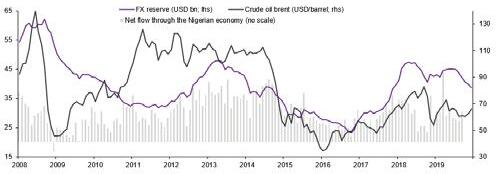
Over the past 12 years, we identified three periods of major drawdown in oil price:
1. H2 2008 at the time of the Great Financial Crisis, 2. H2 2014 reflects slowing global growth, 3. Q4 2018 period of rising trade war uncertainty.
Each period tallies with an increase in market volatility and lower net flows. We observe in Figure 1 that preceding these periods of declining oil price, there are stressed periods during which net flows and especially inflows increased, reflecting efforts from the government to diversify its FX entrances by creating favourable conditions for foreign investors via specific investment windows in the FX and fixed income markets.
Then, following the periods of oil drawdown, when oil price recovers erratically and market sentiment momentum improves, net flows and inflows increased as well, reflecting the return of investors’ confidence in the oil-reliant economy. After analysing and highlighting economic cycles, we understood how the country’s fundamentals and structural environment affect the different sources of flows and we see consistency behind the use of inflow, outflows and oil price as explicative variables in our FX reserves forecast.
Figure 2: FX reserves forecasting

Figure 2 shows our statistical modelling of Nigeria FX reserves, estimate to average USD43.1bn in 2020. In line with our economic outlook, we note that the projected trend remains sustainable though slightly declining within the year. In the short-term, we expect an increase in reserves supported by the stabilisation in oil price, coupled with the upcoming Eurobond issuance in Q1 and the gradual recovery in FX inflows on the back of improving sentiment for risky assets. In the second half of 2020, the slight decline in reserves is induced by lower oil price expectations, but no major pressure is expected on the currency over the year.
Along with the three inherent indicators, we list additional adjacent risks to FX reserves based on Nigeria current economic position, with the aim of helping determining the risk of further reserves shortage.
Global USD liquidity is an important factor to oil exporter countries as Nigeria, and consequently impacts the level of FX reserves. US tightening monetary cycles along with slowing credit growth in China and rising protectionism has led to periods of strengthening dollar and thus a dollar rarefaction. Moreover, global USD liquidity shortage often comes along with rising aversion for risky asset, weighing on foreign investment into developing countries.
Structural risks emphasized by the gap between oil sales receipts and Nigerian oil price, raises concern. The average price for the country’s Forcados crude averaged USD65/barrel over the past two years. But during the same period, treasury receipts from oil sales were almost inexistent. While lower-than-anticipated oil output along with volumes lost to oil theft explain some of the decline, NNPC’s massive revenue withholdings coupled with an increase in suboptimal sales arrangements are also to blame.
Moreover, we have concern about the Excess Crude Account (ECA) given the lack of records and transparency of money-in and -out the fund. We note that every time a disbursement was made from the ECA to the three tiers of government, the foreign exchange reserves have been reduced. Plus, budget instability and recent decline in FX reserves, clearly attest the mismanagement and ineffectiveness of the ECA. This suggests excessive spending are made from this account which is a source of Nigeria foreign exchange reserves depletion.
Fiscal imbalances and budget instability represent a risk for FX reserves as well. FGN has heavily rely on overdraft financing from the CBN over the past years and approximatively 40% of fiscal deficit was financed by the CBN overdraft facility over the last three years. The net overdraft loan reached NGN4.8bn in August 2019 and represents a large amount of liquidity spilled into the economy. This contributes to raise money supply along with inflation expectations, impacting negatively foreign investors’ appetite and limiting their USD inflow entrance. Further pressures on the currency and FX reserves are subsequent damages.
External debt costs have risen markedly in Nigeria following the considerable amounts of concessional external borrowings and Eurobond debt issuance in recent years. The level of external borrowing, expected around 15.2% of GDP this year, remains sustainable but concerns are about the rising pace of external debt (+65.8%yoy in 2018) which translates into higher maturity profile including the USD2.0bn hard-currency debt maturing this year.
Furthermore, as the Debt Management Office relied heavily on domestic sources for financing deficit in 2019 –including CBN’s overdraft financing and higher borrowing on the domestic bond market–, domestic bond issuances are likely to decline this year in favour of external borrowings both concessional and Eurobond. Even though this could support FX reserves accretion in the shortterm, rising external debt service costs will intensify the country’s vulnerability to external shocks and its over-reliance on USD liquidity. This consequently exacerbates the country’s dependence to oil, and contributes in pressuring the FX reserves.
Contributor’s Profile
Lydia Rangapanaiken is an Economist at FCMB UK in London, Lydia covers the fixed income strategy within Sub-Saharan Africa. She specialised on Sub-Saharan African economies with a specific focus on Nigeria, Ghana, Kenya and WAEMU countries, by working as an Economist for Ecobank in London, after starting her career as an Emerging Markets Economist at BNP Paribas Asset Management. She holds a Master degree in Finance from Assas-Sorbonne University (Paris II) and has, since then, built a strong background in financial markets analysis and asset allocation within the developing markets.
By Annabel Bishop, Chief Economist, Investec Bank Limited South Africa

outh Africa is at risk of seeing an economic growth rate of below 1.0% year-on-year in 2020 as a number of structural problems remain unresolved. This comes after a growth rate of likely below 0.5% year-on-year in 2019, not least due to substantial, periodic losses of electricity supply. Not all areas of South Africa’s economy performed poorly in 2019, the private sector made a substantial contribution to capital expenditure in the middle two quarters, likely returned further investment in Q4.19 and is expected to do so through 2020, providing support to GDP as the investment drive continues to gain traction. The private sector accounts for 70% of fixed investment in South Arica, while government accounts for only 16% and public corporations below 15%. Private business enterprises saw capital expenditure growth rates of 15.8% quarter on quarter seasonally adjusted annualised (qqsaa) in the second quarter of 2019, and 10.8% qqsaa in the third quarter, with a positive outturn likely for private sector corporates’ fixed investment growth in Q4.19 as well.
However, Government likely returned negative rates on fixed investment in 2019, with public sector capex down -16.3% qqsaa in Q2.19, and -17.8% qqsaa in Q3.19, after contracting by -2.1% qqsaa in Q1.19. 2020 would see further contraction in government fixed investment if projects budgeted for do not go ahead, while this is also an area that risks budget cuts as government seeks to reduce expenditure to avoid a Moody’s credit rating downgrade. Moody’s is scheduled to deliver its country review on 27th March (with the Budget in February). The agency has already placed South Africa’s long-term sovereign debt on a negative outlook towards the end of last year, indicating that it plans to downgrade South Africa to sub- investment grade, from its rating on the last rung of investment grade, if South Africa does not make the necessary changes that would allow its rating to return to stable. Specifically, Moody’s has said South Africa would avoid a downgrade “if the government's efforts to rein in spending, improve tax compliance and lift potential growth became
increasingly likely to successfully stabilize debt ratios. “National treasury has put forward key areas where expenditure cuts need to be made to consolidate government’s finances materially, which specifically includes cutting above inflation civil servants’ remuneration growth.”
Consumption expenditure by government grew in each of the first three quarters available for 2019, while government debt levels rose notably. Borrowings have been used to top up current expenditure, resulting in the current fiscal balance being in deficit (difference between revenue and current expenditure, and current expenditure includes civil servants’ compensation). Government consequently continued to make a negative contribution to national savings and continued to borrow the bulk of its new issuance of debt in the local market. (Current government expenditure also includes rent, maintenance and interest payments and expenditure on goods and services). When the current fiscal balance is in surplus, government is able to fund its consumption from its own revenue, and not from others via borrowings. With foreign investors funding just under 40% of South Africa’s government debt, and government a dissaver while household savings are relatively low, corporate savings have been a key contributor to funding the rapid expansion of government debt and expenditure that has occurred over the course of this decade.
Expenditure cuts in government fixed investment instead, would detract from economic growth, with previously unspent funds allocated to government infrastructure also holding the potential to contribute meaningfully to economic activity in 2020 if spent. Many of government’s infrastructure projects are small enough to easily be undertaken by small to medium size contractors and it is crucial these are undertaken to support growth and employment creation.
Household savings remain low, at -0.1% of disposable income (after tax income) through 2019, while household debt to disposable income is relatively
high, above 72% of take-home pay (disposable income). Unemployment rates are high in South Africa, 29% in Q2.19 and Q3.19, while consumer confidence is low, turning negative in Q3.19 last year. Real disposable income growth slowed in Q3.19, to 0.1% qqsaa, leading HCE growth lower, to 0.2% qqsaa, and contributing to the weak GDP growth outturn in Q3.19. Spending on semidurable and non-durable goods contracted and slowed in the durable and services categories on the back of weaker confidence and real disposable income growth. CPI inflation dropped in Q4.19’s first monthly readings, to below 4.0% y/y, which will have a negative impact on real disposable income growth in that quarter. Bank lending conditions remain relatively tight.
Load shedding, which has escalated through the stages towards the end of this decade, has contributed to weakening GDP growth. Load shedding has negatively impacted economic growth, and so incomes and employment, with retailers without generators (typically small retail ers) experiencing stock and trading losses, reducing growth and earnings potential. Stage six load shedding was reached towards the end of last year, taking businesses off the grid for longer, with heavy industry negatively affected by the power fluctuations.
The World Bank has cut its growth forecast for South Africa to 0.9% y/y for 2020, from 1.5% forecast previously, and for 2021 to 1.3% y/y, from 1.7% y/y previously. The Bank stated “(i)n South Africa, power cuts and financial stress constrained growth and worsened fiscal deficits.” “The outlook is …markedly weaker than previous projections. Increasingly binding infrastructure constraintsnotably in electricity supply—are expected to inhibit domestic growth, while export momentum will be hindered by weak external demand.” The Bank added that from its current economic growth estimate of 0.4% for 2019 “South Africa, growth is expected to firm to 0.9 percent in 2020, before strengthening to an average of 1.4 percent in 2021-22. This assumes that the new administration’s structural reform agenda gathers pace, that policy uncertainty wanes, and that investment—both public and private—gradually recovers.”
South Africa has seen close to three years of materially declining consumer price inflation,
chiefly caused by food price inflation falling from double digits in 2016 on the back of the severe drought in that period, to below 3.0% y/y. However, this trend cannot be relied on to continue, and so moderate or even maintain CPI inflation going forward. Volatility in South Africa’s long-term inflation trajectory is likely, due to the water scarce country’s high propensity for drought. Food prices have a significant effect on the overall CPI, as food (and non-alcoholic beverages) price inflation accounts for close to 20% of the CPI. Climate change exacerbates the problem of water scarcity in South Africa, with higher mean temperatures compounding the difficulty in raising agricultural productivity. The increased frequency of extreme weather events is also linked to climate change, including cyclones and tornados as well as droughts, negatively affecting agriculture. SA’s deteriorated government finances, including rapidly rising debt projections, make sufficient assistance from the state unlikely for farmers, particularly as the country’s infrastructure is already weak in a number of key areas, with indications that climate change will increase this decade. SA also lags in the transition to clean energy.
“South Africa is at risk of seeing an economic growth rate of below 1.0% year-on-year this year as a number of structural problems remain unresolved.”
Contributor’s Profile
Annabel Bishop joined Investec in 2001, and has worked in the macroeconomic, risk, financial market and econometric, among others, fields for around 25 years. Annabel is the holder of the Sake/Beeld Economist of the Year title for 2010 and has won numerous monthly Reuters Econometer awards, and various Focus Economics (Economic Forecasts from the World’s Leading Economists) categories for correctly forecasting a range of economic variables. She has authored a wide range of in-house and external articles, published both abroad and in South Africa. She has also lectured at Gibbs, the University of Pretoria, Wits, UJ and other academic institutions, and has presented at various national and international conferences.
By Thea Fourie, Senior Economist Sub-Saharan Africa, IHS Markit Economics

ambia’s real GDP growth rate is expected to recover to an estimated 2.5% during 2020. Windfalls such as an improvement in agricultural production combined with a stronger international copper price steer the GDP growth recovery. Lower food prices are expected to push headline inflation back into the target range of 6%-8% by end-2020. IHS Markit assumes a 50-basis point cut in the Bank of Zambia’s policy rate in Q4 2020 as a result. Structural impediments, such as a rising public sector debt burden and narrow government tax base, high reliance on copper-related export earnings and high susceptibility to adverse weather conditions continue to constrain Zambia’s near-term growth prospects.
The Stanbic Bank Zambia Purchasing Managers Index (PMI), compiled by IHS Markit, remained below the 50.0 neutral level for most of 2019, pointing to a harsh economic backdrop. Weak domestic demand conditions impeded companies’ new orders growth and employment while rolling electricity blackouts intensified during the fourth quarter. Low water levels in major water reservoirs left electricity generation down by 5.8% year on year (y/y) during the first 10 months of 2019 while electricity consumption fell by 8.0% y/y over the same period. Business confidence dropped sharply, with some respondents concerned about business conditions. Optimism was at the second lowest level in three-and-a-half years during December 2019 but hopes for an improving economic environment in 2020 supported a positive outlook at several firms.
Although IHS Markit finds it highly unlikely that Zambia’s GDP growth rate could recover to the average growth of 6.0% recorded over the 20202015 period, we are expecting a moderate rebound in economic activity to 2.5% in 2020 from an estimated 1.5% in 2019.
Windfalls such as a strong rebound in agricultural production combined with higher international copper prices assumed during 2020 steer the GDP growth expectation.
Despite a delayed start to the rainy season, initial indicators suggest that precipitation between November 2019 and the start of the January 2020 rainy season in the key maize producing areas of Zambia has been mostly adequate to facilitate planting and ensure stronger agricultural produc-
tion during 2020. This follows two consecutive years of below-average cereal production that will leave an estimated 2.3 million people food insecure during the January-March 2020 lean season. Zambia’s cereal imports consequently increased to 250,000 tonnes in 2019 from roughly 90,000 tonnes during 2018. The adverse weather conditions not only impeded agricultural production, which fell by 7.6% y/y during the first half of 2019, but also fuelled food price inflation and forced rolling electricity blackouts during the second half of 2019, given the economy’s high reliance on hydro-electrical power and inadequate surplus electricity capacity elsewhere in the economy.
Additionally, a modest return to growth in mining production is assumed during 2020. Copper production fell by 6.6% y/y during the first ten
months of 2019 as the industry grappled with policy uncertainty, higher taxes, rising electricity tariffs and delayed Valued Added Tax (VAT) refunds.
Copper and copper-related products still account for more than 75% of Zambia’s total visible export earnings, remaining a primary source of external liquidity and a key driver of overall mining production.
International copper market sentiment improved markedly over the late November-December 2019 period, primarily on optimism over a ratcheting down in trade tensions between the US and China. Concerns over the impact of the Coronavirus outbreak on economic activity in China left the international copper price down significantly during January 2020 and has altered IHS Markit’s copper's outlook for 2020 from one of deficit with rising prices to a potential surplus, with weak pricing in the first half of the year. The disruption to the mainland Chinese economy represents a net reduction to aggregate copper demand, IHS Markit estimates show. The size of the collateral damage brought on by disruptions to Chinese manufacturing to the overall Chinese and global economies depends on how long factories remain idle. While the disruption is potentially severe, once conditions return to normal, we believe the market will recapture much of its recent losses, with international copper prices marching back toward $6,200 per metric ton during the second half of 2020. The stronger international copper prices pose positive for Zambia’s exchange rate outlook post Q1-2020. The kwacha exchange rate depreciated by 23.4% on average against the greenback during 2019, fuelling price pressures in the economy and consequently prompting higher interest rates during the year. The Bank of Zambia hiked its policy rate by 175 basis points during Q4-2019 as inflation edged up to 11.7% by end-2019, well above the Bank of Zambia’s inflation target range of 6%-8%.
Headline inflation is expected to trail down to an estimated 7.0% by end-2020. The slowdown in price increases could, in IHS Markit’s view, open the opportunity to lower the Bank of Zambia’s policy rate by an estimated 50 basis points towards year-end. Risks to the medium-term inflation outlook remain significant, nonetheless. Ongoing food price increases, rising electricity imports and electricity tariffs, lack of fiscal consolidation, and high external debt-servicing obligations
continue to pose a risk to the central bank's medium-term inflation outlook, the Bank of Zambia warns.
IHS Markit projections suggest that public sector debt levels could reach an estimated 98% of GDP by end-2020. A fast-pace public sector investment program, increasingly financed through nonconcessional external debt holdings, the escalating local-currency denominated interest rate burden combined with an overall slowdown in GDP growth contributed to the Zambian government’s debt predicament. Fiscal year 2019 saw the implementation of some fiscal consolidation, with a primary focus on the indefinite suspension of non-core public sector investment programs..
The Bank of Zambia reported that the fiscal deficit (excluding amortization) totalled 5.8% of GDP in 2019 and 8.9% of GDP (including amortization), compared with a target of 6.5%. Payment arrears to state contractors and a sharp drop in publicsector investment spending prevailed. For fiscal year 2020 the government has set a budget deficit target of 5.5% of GDP. Total foreign financing and grants will make up the largest financing share of the budget deficit (including amortisation) of ZMW30.9 billion, amounting to an estimated 9.4% of GDP. Domestic financing is budgeted at roughly 1.1% of GDP during 2020. External debt equates roughly to the Zambian government's 2020 infrastructural budget (8.1% of GDP, according to IHS Markit's estimates), dominated by energy projects, road infrastructure, water and sanitation, and airport expansion projects. These infrastructure projects fall within the scope of the government's efforts to limit new non-concessional loans and revoke non-critical projects and are financed primarily through the disbursement of existing loan facilities. However, lower public sector investment will continue to impede Zambia’s growth prospects during 2020.
Thea Fourie is a sub-Saharan Africa senior economist at IHS Markit, south African office. She is responsible for analysing and forecasting economic developments in South Africa, Angola, Zambia, Mozambique, Namibia, Comoros, Madagascar and reunion. She has over 20 years of experience in the financial and consulting industry. Fourie holds a B.econ (hons.) degree from the University of Pretoria and is fluent in both Afrikaas and English.
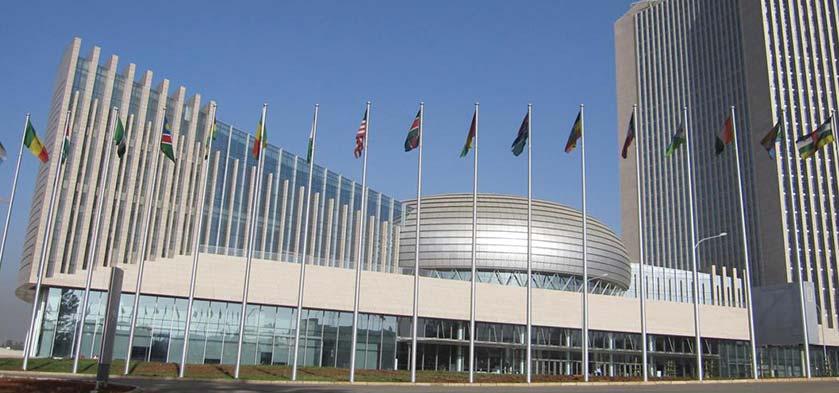
By Roddy Barclay, Director of Intelligence and Analysis, Africa Practice London
olitics
The 22 African countries that will head to the polls in 2020 do so in a rapidly changing digital space. Electoral technologies have improved significantly with biometric systems to reduce the most brazen forms of ballot box stuffing that characterised some elections of the past. But sophisticated electoral fraud has moved into the digital sphere while campaigning is also increasingly finding a voice through digital channels. While this opens up the potential for citizen participation and engagement, it has also surfaced a number of issues linked to the spread of false news, hate speech and exploitative tactics, sometimes in relatively sophisticated forms.
Some of the headline elections in 2020 will be Ethiopia, Guinea and Côte d’Ivoire, all of which face landmark elections. Ethiopia’s general elections will test Prime Minister Abiy Ahmed’s decision to open the political space, fragmenting the dominance of his ruling Prosperity Party, which remains the only party of national significance, but which will now face competition to this position on multiple fronts. With Facebook becoming one of the primary channels for social and political engagement in the country, it is likely that tensions in the digital sphere will also find their corollary on the streets, providing a heated context for the elections, even if Abiy and his party are ultimately likely to emerge with a robust majority.
Meanwhile, President Alpha Condé’s third term ambitions will face stiff – and at times violent–opposition in Guinea. As the President seeks to push through constitutional reforms and stick to a tight electoral calendar, there is a very real risk that
Guinea could tip into a constitutional crisis should the presidential election (currently scheduled for October) fail to hold by the end of the year. The picture in Côte d’Ivoire is even less certain with President Alassane Ouattara’s threat to stand premised on whether his similarly ageing arch- rivals Laurent Gbagbo and Henri Konan Bedié choose to run or not. Current signs suggest this may well be the case, in which case a familiar cast at the ballot box could fan tensions in society that reach into parts of the security apparatus. Côte d’Ivoire has come a long way since the 2010-11 crisis that bought Ouattara to power, and a slide back into conflict seems less likely under the current disposition. But 2020 will certainly present a test of this assertion.
Beyond elections, 2020 will see a number of leaders in countries as diverse as South Africa, Angola and Ethiopia seeking to advance progressive reforms in complex systems that present major structural and political hurdles. In all three instances, economic performance is constricting the room for manoeuvre, underlining the interconnections between politics and the economy.
Although the World Bank recently cut its growth forecast for sub-Saharan Africa to 2.9%, this is driven heavily by the sluggish performance of South Africa and Nigeria, whereas there are a number of bright spots across East and West Africa where many economies will continue to grow above 5%. Diversified economies like Senegal, Ghana, Kenya, Ethiopia and Côte d’Ivoire will be the stand-out performers, provided politics doesn’t ensnare
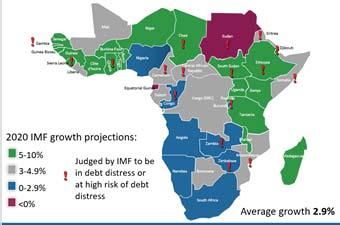
continued economic growth. Meanwhile, commodity-dependent countries like Nigeria, Angola, Gabon, Zambia and Equatorial Guinea will face more challenging transitions to try and diversify their sources of revenue generation and growth. And where this commodity dependence has also been accompanied by lax fiscal approaches as has notably been the case in Zambia, tough decisions will need to be taken to stave off a deeper economic crisis.
The economic powerhouse South Africa is already embarking on a process of budgetary cuts and fiscal belt tightening as it struggles to respond to a stagnant economy burdened with increased government costs, notably from spiralling debt within its mismanaged parastatals. President Cyril Ramaphosa is taking all the right steps, even if his party is not aligned behind him on this, but the sheer scale of reform required to tackle the mismanagement and structural inefficiencies that have come to characterise South Africa’s economy in the last decade is likely to overwhelm the current administration. An imminent credit ratings downgrade by Moody’s is likely to add additional woe, while ANC factions opposed to Ramaphosa’s reforms are likely to be put to work in blocking initiatives that seek to improve government accountability or cut costs, setting the stage for an interesting political tussle in 2020.
Policy and regulatory
Under pressure from burgeoning and increasingly expectant electorates, African governments are keen to spend. Yet with concerns rising over the trajectory and sustainability of African sovereign debt, many governments are looking to how they can generate more revenues internally. On a positive note, a core focus has been efforts to broaden the tax base through capturing large parts of the economy that have long evaded scrutiny, as well as clamping down on illegal tax evasion tactics.
Within the formal economy, commodities remain a low-hanging fruit, even if subdued commodity prices have steadied the hand somewhat. Nevertheless, the strident position taken by Tanzanian President John Magufuli while representing a more extreme form of resource nationalism is not entirely unique, as was evidenced by DRC’s recent revision of its mining fiscal terms and other moves made in countries as far afield as Zambia, Madagascar and Mali.
Beyond extractives, debate around digital taxes is likely to grow apace. While the African Tax Administration Forum (ATAF) is working closely with the OECD on global and regional initiatives, some African governments are taking a more unilateral approach, with mixed results. Uganda’s Over The Top Services (OTT) Tax has failed to have the reach it intended with users of services like Whatsapp using VPN’s to avoid paying the levies on data. Meanwhile, countries like Kenya and South Africa are considering potentially more far-reaching digital taxes that will shake up the sector in years to come.
Beyond sectoral taxation, major global themes on climate change, plastics pollution and public health are also likely to shape the tax debate across Africa. The growing alignment between global agendas and the desires of African governments to regulate (and tax) areas of the economy that are detrimental to society, will see a continued push for new legislation and regulations governing the way businesses operate and interact with their consumers. Businesses will need to respond with similar alacrity to the fast-paced changes being witnessed across the political and policy landscape if they are to continue thriving.
Contributor’s Profile

Roddy heads up the Intelligence and Analysis team at africapractice, a strategy and communications consultancy that specialises in managing external relations. In this role, he oversees a team of political risk analysts and business intelligence consultants spread across Africa, helping clients to mitigate stakeholder and policy risks, and manage their reputation. Roddy has worked in the political risk advisory industry for over eight years and formerly specialised on West Africa when he worked as a Senior Consultant at the multinational risk advisory firm, Control Risks. He has travelled extensively across the continent, building strong networks and knowledge in over 20 African countries.
By Jan Friederich, Head of Middle East and Africa Sovereigns, Fitch Ratings
overeigns in Sub-Saharan Africa (SSA) largely absorbed the earlier commodity price shock, and median government debt will decline in 2020 after a marginal reduction in 2019. However, weak public financial management (PFM), persistent high-priority infrastructure needs and pressure for improved public services raise risks for debt trajectories. Political and social pressures are significant in the region, but many SSA sovereigns are benefiting from rapid growth. External pressures have eased, but low diversification means vulnerability to shocks is high.
Of the 19 sovereigns in the region rated by Fitch, three have a Positive Outlook and four a Negative Outlook. There are three sovereigns with a rating of ‘CCC’–Fitch does not assign Outlooks for ratings of ‘CCC+’ or below. Benin’s Positive Outlook reflects continued fiscal consolidation and the expected effect of a national accounts revision of key credit metrics. The Positive Outlook on Cote d’Ivoire is driven by strong growth prospects and progress on fiscal consolidation and reforms. The Positive Outlook on Cabo Verde reflects the prospect of continued declines of the still very high government debt/GDP ratio, and increased medium-term potential growth.
The Negative Outlook on South Africa is due to the difficulty of stabilising debt/GDP. In Angola, the Negative Outlook is driven by worsening debt metrics, the continued fall in international reserves and the slow economic recovery. Fitch revised the Outlook on Ethiopia’s ‘B’ rating to Negative due to prospects for continued political instability and potential meaningful economic spill overs. The Negative Outlook on Nigeria is due to the increasing vulnerability from macroeconomic policy settings that raise risks of disruptive macroeconomic adjustments.
Ratings are heavily concentrated at the lower end of the rating scale, with most ratings falling into the ‘B’ category. This reflects relatively weak structural features such as World Bank governance indicators and GDP per capita and, in many countries, relatively high debt.

Key things to watch in SSA during 2020 include:
• Oil producers in the region will remain vulnerable to fluctuations in crude oil prices. Nigeria could also be affected by a flight of foreign investors out of the central bank’s short-term paper.
• CEMAC members may become less committed to fiscal consolidation, jeopardising debt sustainability, while a significant growth slowdown would put pressure on WAEMU sovereigns.
• South Africa’s February 2020 budget review could give further clarity about the prospects of stabilising debt/GDP.
• In eastern Africa, a failure to rein in infrastructure spending could again derail debt stabilisation.
• Elections, notably in Cote d’Ivoire, Ethiopia and Ghana, and social and political tensions more broadly could also affect ratings.
We expect median government debt/GDP to decline slightly in 2020 to around 55%, but the earlier sharp rise from a low of 27% in 2012 means that there are now limited buffers in case of renewed external or domestic shocks. The number of SSA sovereigns with government interest payments exceeding 20% of government revenue, although unchanged from 2017 and 2018, remains at the highest points since at least 2000, pointing to significant risk of debt distress.
Fitch forecasts only a moderate decline in oil prices, to USD62.5/b in 2020 from USD65 in 2019. Oil producers in the region would be affected by a sharper decline as they have not rebuilt external and fiscal buffers that were significantly eroded by the 2014 oil price shock.
Vulnerabilities are building up again in Nigeria. The stability of the naira since mid-2017 is achieved only with the help of a complex set of monetary and foreign-exchange policy measures. Notably, the high reliance on short-term portfolio inflows, particularly in Central Bank of Nigeria Open Market
Operations paper, for boosting international reserves raises the exposure to foreign investor sentiment, which could compound the impact of an oil price shock.
Angola has already implemented major reforms, including the re-structuring of the oil sector under an IMF programme since late 2018. The move to a more flexible exchange rate may address continued foreign exchange market imbalances, but also pushes up the debt/GDP ratio. In terms of recent news on the “Luanda Papers,” while the specific allegations may be new, poor control of corruption is already incorporated in our ratings for the Angola sovereign.
Fitch-rated sovereigns in the Central African Economic and Monetary Community(CEMAC) have stabilised after the oil price hit, making a devaluation unlikely, but they could be affected by a weakening of reform momentum, for example due to social pressures against fiscal consolidation, political instability, and PFM limitations.Congo signed an IMF programme in 2019,although delays in the first review point to high implementation risks. We assume Cameroon and Gabon will renew or extend their IMF programmes, which will terminate mid-2020.
Growth remains strong in Benin and Cote d’Ivoire, the two Fitch-rated sovereigns in the West African CFA franc zone (WAEMU). Fitch does not expect the new common currency of the Economic Community of West African States (ECOWAS, including WAEMU, Ghana, Nigeria and Cabo Verde), planned for 2020, to proceed in the medium term. The recent currency reforms in WAEMU, which come under the banner of the ECOWAS common currency Eco are mainly symbolic, as the peg to the euro will be maintained and the currency will continue to benefit from a convertibility guarantee. As a result, the changes to the currency do not fundamentally alter the external liquidity risks of the two Fitch-rated WAEMU members, Benin and Cote d'Ivoire, or of CEMAC if similar reforms are implemented there.
South Africa’s rating is under pressure from weak growth and the difficulties of containing expenditure in the context of high inequality. South Africa’s budget, to be released in February, will be key to gauging the ability of the government to stabilise debt in the medium term. In October, the government presented fiscal projections with government debt/GDP rising by 25pp by 2027-2028 but prom-
ised consolidation measures to prevent this from materialising. Namibia and Lesotho are both hit by the trend decline in customs revenue from the Southern African Customs Union (SACU)with South Africa, a key source of revenue for them, and low trend growth.
In Zambia, the government has yet to announce details on scaling back an ambitious but costly infrastructure programme that would see debt rising to dangerously high levels. The lack of a clear fiscal adjustment path means that an IMF programme, although not impossible, is not included in our forecasts. With foreign reserves already low and access to international markets effectively closed, repayment of its 2022 Eurobond could be challenging. Like several other countries in the region, Zambia is suffering from severe drought that is affecting electricity generation and therefore overall economic performance.
Mozambique will seek to settle outstanding SOE (State-Owned Enterprises) liabilities following the conclusion of a Eurobond re-structuring. Hurdles for an IMF programme to ease external financing constraints are still significant given the high debt. Domestic political tensions also remain a challenge, but in the medium term the development of massive LNG export capacity will support growth and fiscal and external finances.
Ethiopia and Kenya’s debt will decline largely due to strong economic growth and some scaling back after years of infrastructure investment. In Ethiopia, the rapid political and social transformation since the arrival of the new prime minister in 2018 has raised uncertainty about the political outlook. In Kenya, the recent repeal of a cap on lending interest rates could support economic growth.
Rwanda and Uganda will have continued rapid increases in debt to GDP, albeit at still sustainable levels particularly given heavy reliance on concessionary financing. The debt rise reflects ambitious infrastructure programmes intended to spur growth. In Uganda, progress towards a final investment decision on oil production, which had been pushed back repeatedly, would be positive but remains uncertain.
Kenya is the farthest along in its development strategy and we expect progress on fiscal consolidation, although weak government revenue growth will limit deficit reduction.


The Perfect Storm: Money + Opportunity
Africa’s energy deficit affects over 600 million people – more than half of the continent’s population.1 Closing this gap requires considerable financial investment. With the world’s youngest workforce and falling trade barriers, the continent has become an attractive destination for infrastructure investment, particularly in the power sector. Despite the attractiveness of the opportunity, why are so many projects struggling to access the much-needed capital?
The simple answer is that most projects struggle to overcome the hurdle of ‘bankability’. In the broadest sense, bankability refers to the extent to which a project is considered financeable by conventional lenders such has developmental finance institutions. The lenders provide the debt financing for the project and therefore have a vested interest in ensuring that the project is structured in a manner that minimises the risk of default. In essence, bankability encompasses an assessment of a project’s collateral, future cash flows and probability of success.
Sharing the Burden with the Private Sector: Emergence of IPPs
Traditionally, utilities were responsible for the generation of electricity and selling to the endusers. Given the high cost of power generation infrastructure and the challenges faced by state owned utilities to finance such projects, Independent Power Producers (“IPP”) have entered many African markets. An IPP is an entity that is not a public utility but owns and operates a power generation facility for the sale of electricity to utilities and/or end-users. The objective of the IPP and its developers is clearly commercial and driven by a potential return on investment. Through IPPs, governments can use private resources to address developmental needs. Furthermore, unlike the
traditional way of financing electricity generation, (i.e. public financing) using IPPs allows for reallocation of the project risks between the government and the private sector.
Well allocated risk is critical to the success of a power project. It ensures the equitable distribution of the economic benefits associated with the risk that has been assumed. The risk will typically be priced by the developer into the tariff and be reflected in the internal rate of return (“IRR”) for its shareholders. It is essential that the allocation of risks justifies the level of return on investment, and vice-versa. If the risk allocation results in a high tariff relative to the risk that has been assumed by the IPP, the outcome may be off-taker default or cancellation of the power purchase agreement (“PPA”). Conversely if tariffs are too low resulting in insufficient project returns, the project will be either un-bankable or unattractive for the developers.2 Both instances result unfair economic benefit for one party at the expense of the other which is not sustainable.
Bankability vs Profitability: Hiding behind the Lenders
The higher the risk, the higher the return – power projects in emerging markets are more likely to generate a higher return than projects in developed markets. The reason for this is because the developers will price the risk of developing the power project, raising finance, securing fuel supply for the plant, constructing the plant, and operating and maintaining it for the full term of the PPA due to the perception that these risks are more likely to materialise in an emerging market.
The lenders generally have a more conservative appetite for risk and will independently assess the accuracy of technical and economic assumptions of the project. However, whilst the risk assessment
01.https://www.afdb.org/en/the-high-5/light-up-and-power-africa-%E2%80%93-a-new-deal-on-energy-for-africa accessed (09 September 2019). 02.“Understanding Power Project Financing” African Legal Support Facility (2016) p. 69 -70.
of lenders may be similar to that of the developer, the conclusions and outcome of the assessment may fundamentally diverge. The primary expectation of the lenders pertains to ensuring that their typically capped returns are sufficient to offset the long-term risks of the project through the expected revenue stream – bankability. Conversely, the objective of the developer is to ensure the profitability of the project for its equity shareholders which will be reflected in the IRR.
Throughout the developmental stages of the project, the off-taker will primarily engage with the developer and have limited interaction with the lenders. The off-taker and the developer typically work together to get the project documents, including the PPA, to be bankable. During this negotiation process, the IPP may invariably argue for certain clauses hiding behind the lenders and bankability as a starting point. The challenge, however, is the conflation of bankability and profitability. A project that that does not meet the bankability standard for financing by the lenders will unlikely reach financial close. However, a project that reasonably allocates more risk to the IPP as opposed to the Government should reach financial close.
The disposition on payments in the event of a termination is perhaps one of the most contentious clauses within any commercial contract and this is no different for a PPA. Typically, termination in a PPA falls into three categories – (i) a default of the off-taker/utility (a buyer default) or a failure of the government to prevent a risk (a political force majeure), (ii) the default of the IPP (a seller default) and (iii) an ‘act of God’ or some form of supervening impossibility of performance (an ordinary force majeure). The market generally accepts that the lenders must be repaid for the debt they provide to the project, regardless of the circumstances pertaining to the termination. Where the buyer is in default or a political force majeure arises, again, the market generally accepts that both the debt from the lenders and equity contribution by IPP shareholders should be re-paid in the termination payment. However, there is some debate in respect of the market position for seller default and this debate illustrates the unreasonable risk allocation placed on utilities. Some developers argue for termination clauses providing for the payment of
equity in the event of seller default. This means that in the event that the IPP itself defaults on its obligations in the PPA to such an extent that the agreement must be terminated, the off-taker/ government will still pay the IPP’s full equity returns in the termination payment.
This kind of structure provides for a theoretically risk-free investment (which is argued for under the guise of bankability). In theory, the IPP has nothing to lose – equity will be paid in full. The argument used is that the off-taker/government will retain the project infrastructure/assets in the country after the termination so the full payment should be due upon termination. But why shouldn’t the IPP be penalised for defaulting on their obligations?
This is just one example of risk being unfairly allocated to the utility (and in turn the government) where the party best placed to mitigate against that risk is the private sector, being the IPP. The majority of state-owned utilities on the continent are heavily subsidised and dependant on government support and the Ministry of Finance/treasury will likely backstop the undertakings of the utility. The lenders will also have a direct agreement in place with the host government. However, the expectation that the host government must absorb the entire risk profile of a project for it to reach financial close diminishes the economic value of private sector participation. Financing and technical skills are an essential component of power projects but equitable risk allocation is also important to ensure that governments can comfortably support various IPPs.
The real question is how much risk should African governments be taking? Whilst there is a developmental need for private sector investment in the power sector across the continent, it is unreasonable for an IPP to expect a risk-free structure. A clear line needs to be drawn between bankability and profitability. An IPP must proverbially speaking, have “some skin in the game” to satisfy the government that there is enough incentive to complete the project. Despite the fact that most African governments do not have the wherewithal to develop power projects at the rate required to address the energy deficit, the market needs to shift towards more equitable terms that are sustainable for all the parties involved.

By Edline Eva Murungi, Associate,
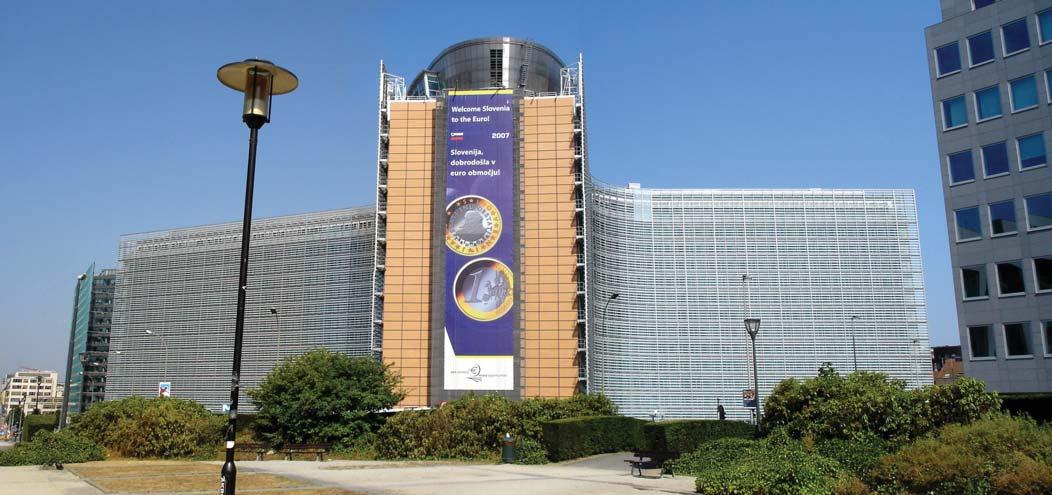
p to now, the boards of institutional investors and asset managers have owed fiduciary duties of care only to their shareholders and companies. In the near future, in the case of investors bound by European Commission (EC) regulation, this will be broadened significantly, with important implications for investors and the public alike.
A fiduciary duty is an obligation to act in the best interest of another and has always been the terrain of corporate law. Traditionally the Board of a company has a direct responsibility to ensure that the collective interest of shareholders is at the forefront of the decisions made. Where there is a breach of this duty, action against the directors would ordinarily be instituted by the shareholders or people with a direct link to the corporation.
Now change is in the air. Under the new EC regulatory framework, intended to facilitate sustainable investment and introduce more transparent disclosure requirements, institutional investors and asset managers will now also owe fiduciary duties of care, skill and prudence to beneficiaries and the general public.
Integrating ESG criteria into investment decisions
The EC’s intention is to ensure investors have sustainable investment processes that take environmental, social and governance (ESG) implications into account. Its new regulation on sustainable investment, published in May 2018, sets out

how financial market participants and financial advisors must integrate ESG risks and opportunities into their processes as part of their duty to act in the best interest of investors and beneficiaries
This regulation is part of a series of proposals to clarify ESG criteria and ensure uniform disclosure requirements across the investment chain. The move stems from one of the eight recommendations made by the High Level Expert Group (HLEG) on sustainable finance, an advisory body to the EC.
The next step will be to clarify how asset managers and other investors should take the sustainability factor into account. For this purpose, the EC will start publishing the delegated Acts in December 2019, continuing into 2020 and 2021.
Why should the public be interested in a development of this nature emanating from the EC? The answer is that the development is generally relevant in corporate law everywhere because fiduciary duties are applicable everywhere. In essence, the EC’s approach to sustainable investment makes it clear that ESG and other responsible investment criteria are central, and not tangential, to investment decision making.
“A fiduciary duty is an obligation to act in the best interest of another and has always been the terrain of corporate law.”
A key change is that investors will be expected to publicly communicate how they integrate ESG factors into their investment decisions. Of particular importance is that they give proper consideration to risk and opportunity exposure, and explain how they are exercising due diligence to avoid, minimise and mitigate negative ESG impacts.
From environmental obligations to anticorruption issues
In terms of ESG, the new sustainable investment regulation encompasses the implementation of a wide range of obligations, from environmental and social impact considerations to governance and corruption issues.
In ensuring that law works for all, it will be necessary to develop tools to create avenues for collaboration between the private sector and the state, and therefore the general public and beneficiaries.
In terms of legal application, we have seen ESG aspects being considered and integrated into investment agreements, mergers and acquisitions, infrastructure projects and private equity transactions. To date, there has been limited judicial enforcement as a result of the doctrine that silence, absent a duty to disclose, is not misleading.
More active ESG measurement and reporting What opportunities in terms of risk and duty does this new regulation provide? That question will be answered by analysing the roles of the key players.
The EC’s new framework seeks to create a normative, legally binding standard for applying ESG standards and influencing how investment transactions can be structured for sustainable development. If they are to fulfil their broadened fiduciary duties to beneficiaries and the public, corporations will have to be much more active in assessing and accounting for their ESG impacts. This can be done through sustainability committees and by measuring and reporting on how the duty has been upheld. Key compliance on the part of investors will be required by publishing regular reports on the social and environmental impacts of their activities.
The EC’s strategy is the first plan of this kind to steer a financial sector to help reach climate change goals and, equally importantly, the United Nations Sustainable Development Goals.
However, although the EC regulation is a step in the right direction in responsible investment, it poses certain challenges.
It is not yet clear what geographical reach the regulation will have and whether European companies will be required to exercise these duties even in transactions outside the EU. Does the regulation apply to European investors in African countries, for example? What does it mean for parentsubsidiary liability? Most importantly, what reportting requirements will be necessary?
It is also worth noting that the EC in June 2019 released guidelines on non-financial reporting on climate-related information. These guidelines offer practical suggestions on what to report but are non-binding.
Although issues of jurisdiction and applicability of the investors’ duties are yet to be determined, the EC regulation opens up previously uncharted territory by expanding the fiduciary duty of care to beneficiaries and the public. This is likely to usher in a new era of accountability and transparency in institutional investment and asset management. At the same time, care will have to be taken to ensure that the ESG disclosures are introduced without negatively affecting the markets.
“The
EC’s new framework seeks to create a normative, legally binding standard for applying ESG standards and influencing how investment transactions can be structured for sustainable development.”
Contributor’s Profile

Edline Eva Murungi is an associate based at the Kampala office of leading African law firm, Bowmans.
She advises both local and international clients on a broad range of corporate law matters.
She specialises in corporate restructuring, acquisitions, business mergers, financings and regulatory compliance and also developed significant knowledge of impact investment, responsible investment and all other facets of sustainable finance while pursuing a fellowship in New York. Her experience extends to dispute resolution with specific emphasis on international investment arbitration.
She has an LLB from Makerere University and an LLM from Harvard Law School.
By Shailen Sreekeessoon, Deputy CEO, SBM NBFC Holdings Ltd
he Africa opportunity
After many decades of below par performance, the tide seems to have turned for Africa. With a population exceeding one billion, a large, young and growing workforce, fast adoption of technology, and some of the fastest economies in the world, the continent is becoming increasingly recognized as the next growth frontier.
One of the key challenges preventing Africa from achieving its potential is the availability of funding. Infrastructure is a good case in point.
Good quality infrastructure is vital for the proper functioning of an economy. It increases economic growth through an increase in total factor productivity as well as through its multiplier effect via the spending channel. However, Africa lags most other regions in terms of infrastructure. Recent estimates from the 2018 African Economic Outlook of the African Development Bank point toward a spending requirement between USD 140 billion to USD 170 billion; corresponding to an estimated annual gap of between USD 68 billion to USD 108 billion. (AfDB, 2018). By some measures, it is estimated that if the state of infrastructure in sub-Saharan Africa were raised to an optimal level, it could increase the annual growth rate in the region by as much as 2-3 percentage points.
The funding gap
Yet, the shortfall is persisting prominently because of a lack of financing. Trade finance and project finance are another example of sub-optimal activity due to funding gaps. This has been exacerbated in recent years with the pull-out or otherwise reduction in activity of many international banks from Africa, in contradiction to the continent’s growth story.
Conscious of the need to maintain sound public finances, governments are constrained in their ability to significantly prop up public expenditure to address these funding gaps. Therefore, there is a pressing need to involve private investors in the financing of Africa-based projects, with both local and global funding sources, as the domestic savings rates in many African countries remain low and inadequate to
meet the funding needs of the continent.

Mauritius as a conduit for channeling investment into Africa
This is where Mauritius, as an emerging international financial center, can play a role in channeling investments from regions that have available funding, such as Europe and Asia, to the African continent. Mauritius offers multiple benefits to investors wishing to finance projects and explore business opportunities in Africa. These include:
• A strategic location, with a favorable time zone and series of trade and investment agreements and double taxation avoidance agreements with several countries,
• A favorable business environment – Mauritius ranks 13th among 190 countries globally and 1st in Africa in the World Bank Ease of Business classification a wide range of fiscal and other incentives, including 5 to 10 years tax holidays in selected industries; no currency exchange controls, free repatriation of profits and dividends, no capital gains tax and 100% foreign ownership is allowed,
• A multi-currency trading platform and dual list on the Stock Exchange of Mauritius (SEM),
• A regulatory sandbox license regime, which offers the possibility to conduct innovative business activities for which there exists no legal framework, or adequate provisions, under existing legislation in Mauritius
• An educated and bilingual workforce as well as a hybrid legal system contained elements of English and French laws,
• Strong historical and cultural ties with key European, Asian and African countries.
Already, more than USD 30 billion in direct investment into Africa is held by Global Business Companies in Mauritius, and the amount is expected to grow further going forward. Leading companies and governments in Africa can use the Mauritius jurisdiction to raise capital in an efficient manner an efficient manner for financing their projects.
SBM Capital Markets Ltd (SCML) act as a one-stop-shop for investor services. Besides investment advisory and capital raising on debt and equity capital markets, they also offer depositary services whereby any African company can deposit its shares with SCML and the latter issues Depositary Receipts for listing on SEM. In 2017, SBM raised USD165 million in depositary receipts for Afreximbank. SCML also offers an extended-hours multi-currency platform where companies and high net worth individuals can trade across a wide range of global markets and settle in multiple currencies. Investors can also avail of portfolio management and fund administration solutions. If you would like to discuss further, please reach out to shailen.sreekeessoon@sbmgroup.mu.
African economies to grow by 3.9% in 2020 and 4.1% in 2021. The African Development Bank Group (AfDB) projected the real GDP growth of African economies to pick up from 3.4% in 2019 to 3.9% in 2020 and 4.1% in 2021, but to remain below the region's average growth rate of 5% in the past decade. It expected economic activity in the region to be supported by the expected increase in exports as a result of the African Continental Free Trade Area, as well as by sustained public investments, and strong private consumption. Still, it noted that the region's outlook is subject to domestic and external downside risks, including extreme weather events, socio-political risks amid upcoming elections in several countries, and a slowdown in global economic activity. It added that further monetary policy easing in advanced economies could trigger an inflow of ''hot money'' into African countries, with the associated macro prudential risks and disorderly exchange rate effects.
Moody’s Says Bond Binge Could Prove Risky for Sub-Saharan Africa. A shift in the debt structure of sub-Saharan African governments has increased their vulnerability to financial shocks, Moody’s Investors Service said. Amid favourable conditions in global markets and increased foreign interest in their domestic debt markets, countries in the region have shifted toward private creditors and away from international financial institutions and traditional bilateral partners, said Moody’s. The ratings company sees debt burdens broadly stabilizing between 2020 and 2021, except for South Africa and Zambia. But governments’ higher foreigncurrency debt makes them vulnerable if their economic growth slows or their currencies depreciate
Sub-Saharan Africa Eurobond refinancing to exceed $30bn in next 10 years. The Institute of International Finance indicated that several countries in Sub-Saharan Africa (SSA) will face substantial debt amortization payments in the coming years. It noted that the SSA region's debt-to-GDP ratio grew by 23 percentage points in the past 10 years, as a result of elevated Eurobond issuances. It expected the debt amortization of SSA economies, which totalled $6bn over the past five years, to rise to $6.6bn in 2024 and to $7.4bn in 2025. As such, it considered that attracting non-resident capital for debt rollover will be critical amid wide current account deficits, in order to avoid signifi-
cant depreciation pressure on local currencies.
IMF’s Georgieva Voices Concern About Rising African Debt Levels. The International Monetary Fund is worried about rising debt in Africa, with about 40% of countries on the continent at distressed levels, The IMF hinted that debt levels in the region have been rising as governments struggle to collect and grow revenue while increasing their budgets. South Africa’s ratio is projected to reach 81% of gross domestic product by 2028 and Kenya recently doubled its debt ceiling to match the size of the entire economy. In Zambia, government debt, including publicly guaranteed obligations, is set to increase to 92% of GDP this year, and 96% in 2020, according to the IMF.
DRC Economy vulnerable to deterioration of external conditions. S&P Global Ratings indicated that the Democratic Republic of the Congo's (DRC) external position is fragile, with foreign currency reserves decreasing to a critically low level of about US$302m, equivalent to one week of imports, at the end of October 2019. It noted that the government resorted to the Banque Centrale du Congo (BCC) to finance its fiscal deficit due to high spending pressures and weak oversight during the political transition, as well as to limited financing options, which depleted the BCC’s foreign currency reserves. It added that the DRC's ability to meet its financial commitments over the medium to long term will depend on improvements in the country's business, financial and economic conditions.
COTE D’IVOIRE: Growth to average 6.7% over medium term. The International Monetary Fund indicated that Côte d'Ivoire has benefitted in recent years from solid macroeconomic stability, an upgraded infrastructure and an improved business environment, which have allowed the private sector to become the main driver of economic growth. It noted that the country's macroeconomic outlook is positive, as it expected real GDP growth to reach 7.3% in 2020 relative to 7.5% in 2019, supported by robust investment activity, higher cocoa export receipts, and increased social spending. Its projected growth to average 6.7% annually during the 2021-24 period, if authorities continue to follow prudent macroeconomic policies and implement additional structural reforms. However, IMF pointed that the current account is subject to downside risks, including unfavourable terms-of-trade shocks and weaker-than-expected global growth.
Oil prices to average $65 p/b in 2020. ICE Brent crude oil front-month prices continued to trade at between $64 per barrel (p/b) and $65 p/b in the past two weeks, as expectations of a surplus in the global oil market in coming months outweighed concerns about disruptions to Libya's oil output. The International Energy Agency (IEA) projected prices to average $65 p/b in 2020 and added that risks to the outlook include escalating tensions in the Middle East.
Precious Metals: Gold prices to reach $1,600 per ounce by end-2020. Gold prices averaged $1,393 per troy ounce in 2019, constituting an increase of 9.7% from an average of $1,269 per ounce in 2018. Prices were mainly supported by increased investors' holdings of gold Exchange Traded Funds amid lower U.S. interest rates, as well as by the continued purchase of the metal by central banks worldwide as well as a weaker US dollar, heightened geopolitical tensions, uncertainties related to the 2020 U.S. presidential elections, and risks of a disorderly Brexit.
Base Metals: Nickel prices to average $13,825 per ton in 2020. The LME cash price of nickel closed at $13,015 per ton on February 12, 2020, constituting a decrease of 6.7% from $13,950 per ton at the end of 2019. Prices averaged $12,872 per ton so far in February, down by 4.8% from an average of $13,526 per ton in January 2020 and compared to an average of $13,881 per ton in December 2019. Nickel has been the worst performing base metal so far this year. The decline in prices is mainly due to concerns about the demand for metals from China, the world's largest metals consumer, following the outbreak of the coronavirus.
Base Metals: Zinc prices down 13% in 2019, to average $2,075 per ton in 2020. LME zinc cash prices averaged $2,549 per ton in 2019, constituting a decrease of 12.7% from an average of $2,920 per ton in 2018. The decline in prices is mainly due to the prolonged U.S-China trade tensions that weighed on global economic growth and on demand for metals. But zinc price grew gradually, the rise in prices has been driven by worries about supply shortages, as well as the U.S. and China signed the "Phase One" trade deal, which boosted the prospects of higher demand for metals.
Precious Metals: Silver prices to increase by 5% and average $17 per ounce in 2020. Silver prices averaged $16.2 per troy ounce in 2019 and increased by 3.2% from an average of $15.7 per ounce in 2018, supported mainly by a decline in global mine production, as well as by strong photovoltaic demand for the metal. Silver prices averaged $18 per ounce so far this year, overall, prices are projected to increase by 5% to an average of $17 per ounce in 2020.
Base Metals: Copper prices reach four-month low. LME copper cash prices averaged $6,082 per metric ton in the year-to-January 29, 2020, constituting an increase of 2.4% from an average of $5,940 per ton in January 2019, as the U.S. and China reached an agreement on the first phase of a trade deal, and following the expansion of Chinese manufacturing activity. However, prices declined to $5,612.8 per ton on January 29, 2020, the drop in prices was driven by expectations of lower demand from China, the world's top metals consumer, where an outbreak of the coronavirus has raised the prospects of economic slowdown in the country.
Precious Metals: Palladium prices to increase by 48% to $2,275 an ounce in 2020. Palladium prices averaged $2,226 per troy ounce in January 2020, which constitutes an increase of 17.2% from an average of $1,901 per ounce in December 2019 and compared to an average of $1,538 an ounce in 2019. The significant rise in prices is due to the persistently wide production deficit in the global palladium market that resulted from strong autocatalyst demand to meet tighter emission regulations, and from continued supply shortages. Prices are projected to increase by 48% to an average of $2,275 an ounce in 2020, driven by rising autocatalyst demand amid expectations of stricter emissions regulations worldwide.
Precious Metals: Rough diamond production down 4% to 142 million carats in 2019. Global rough diamond production is estimated to have declined by 4% to 142 million carats in 2019, mainly due to lower production in Australia, Botswana and South Africa, which was partly offset by higher diamond supply in Russia and Angola. Global rough diamond output is expected to significantly decrease starting in 2021 as a result of a contraction in diamond supply at the Argyle mine in Australia and at the Diavik and Ekati mines in Canada.

